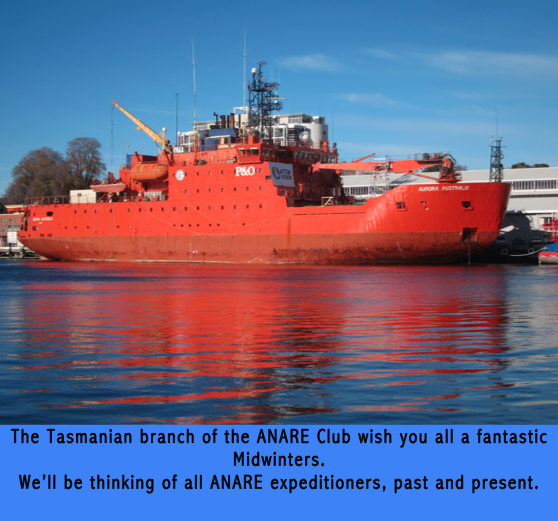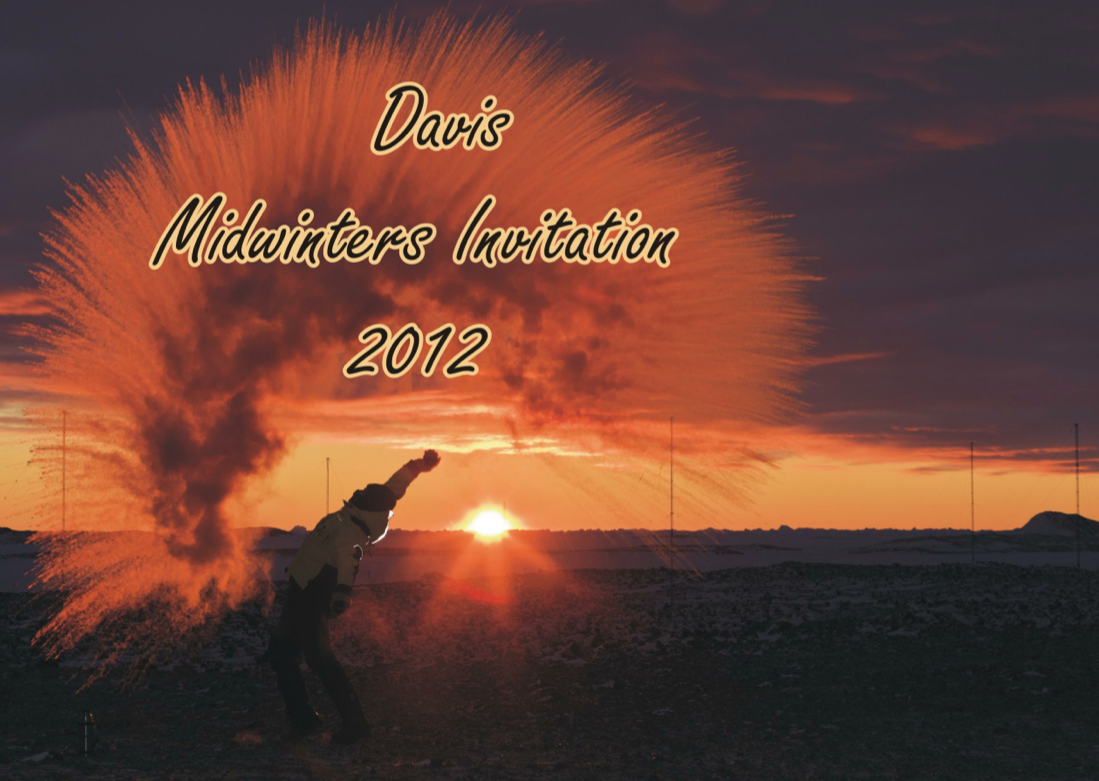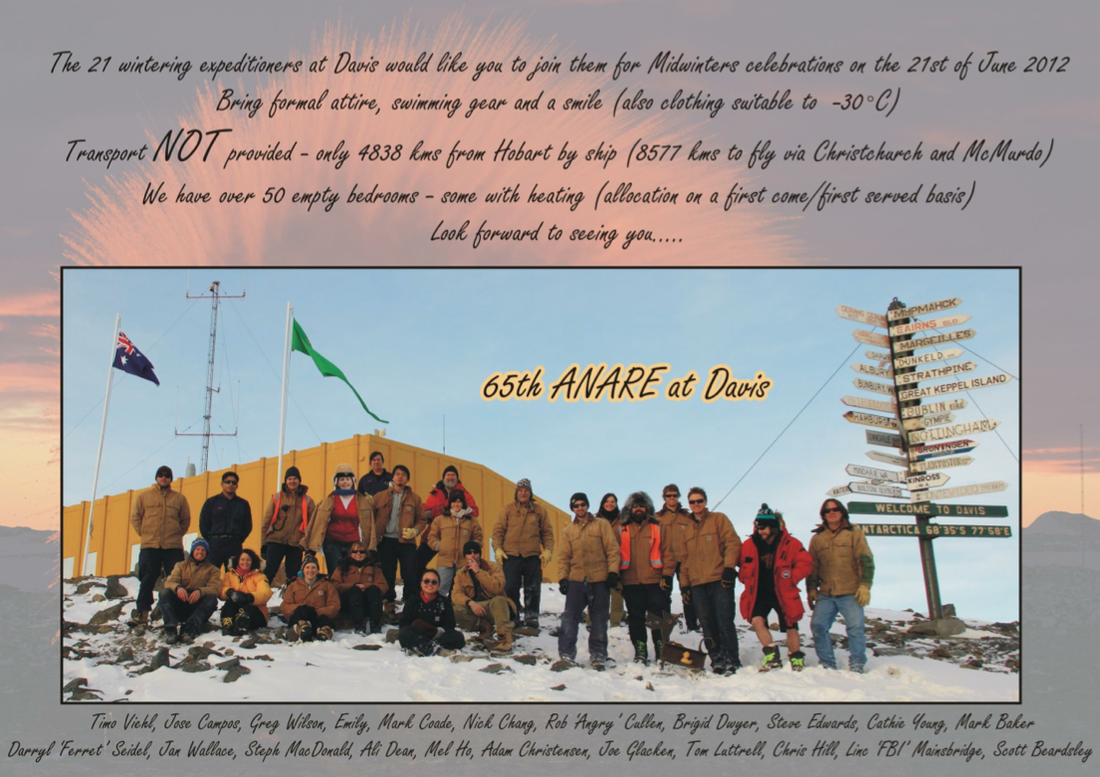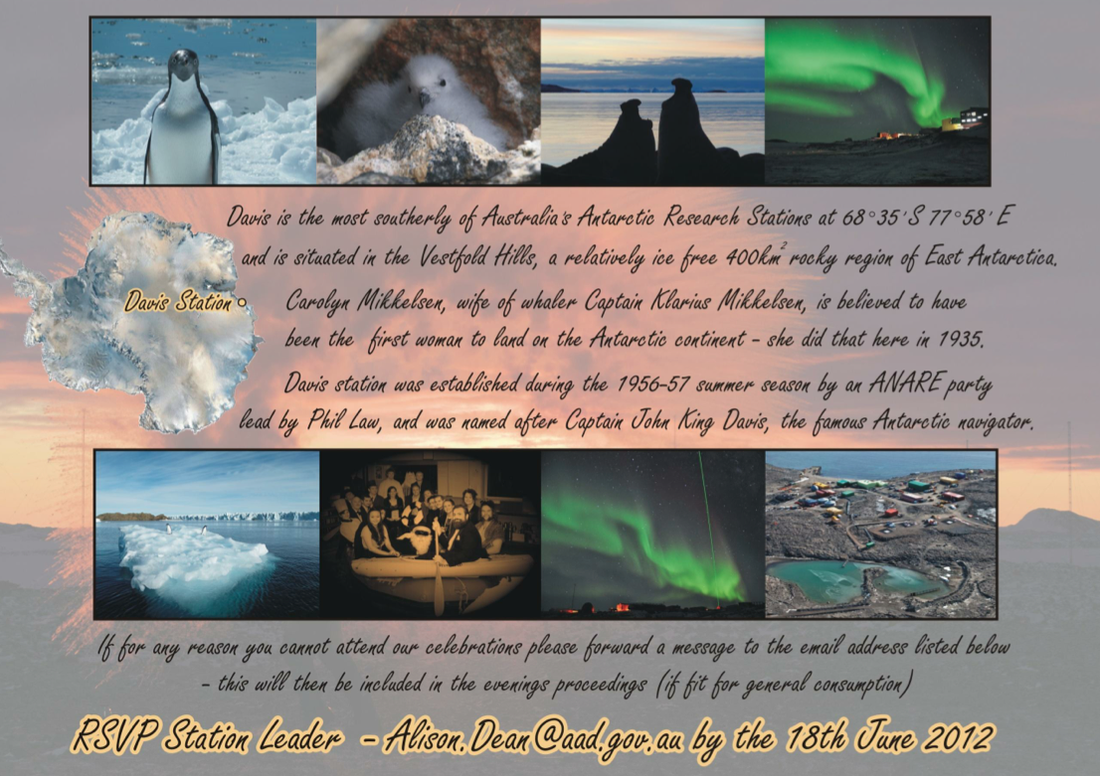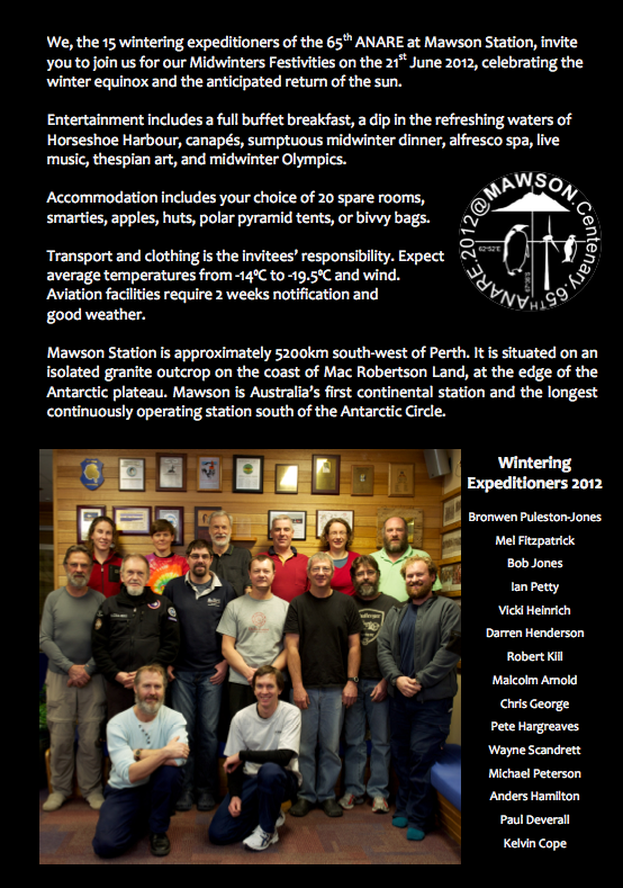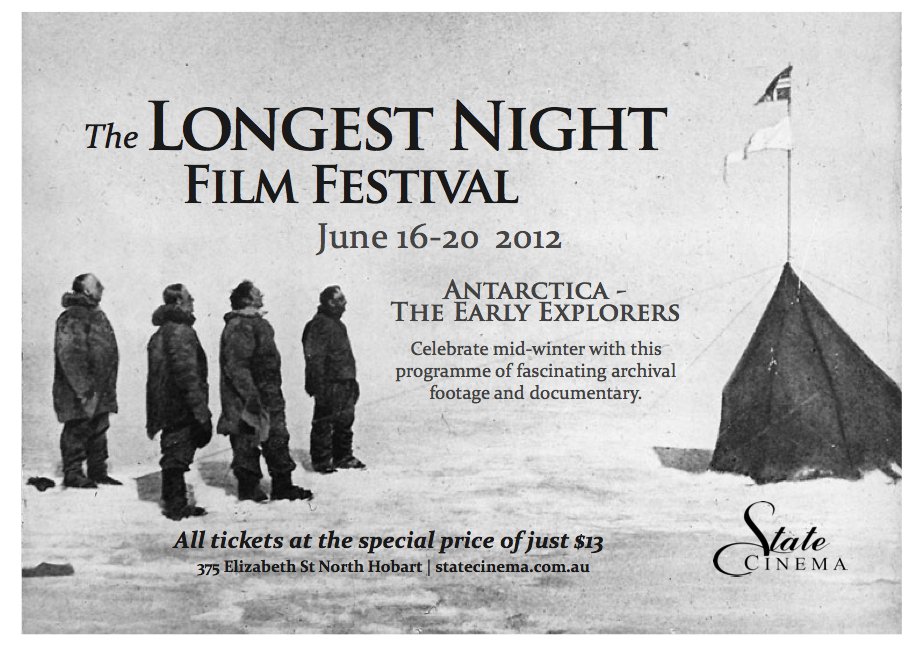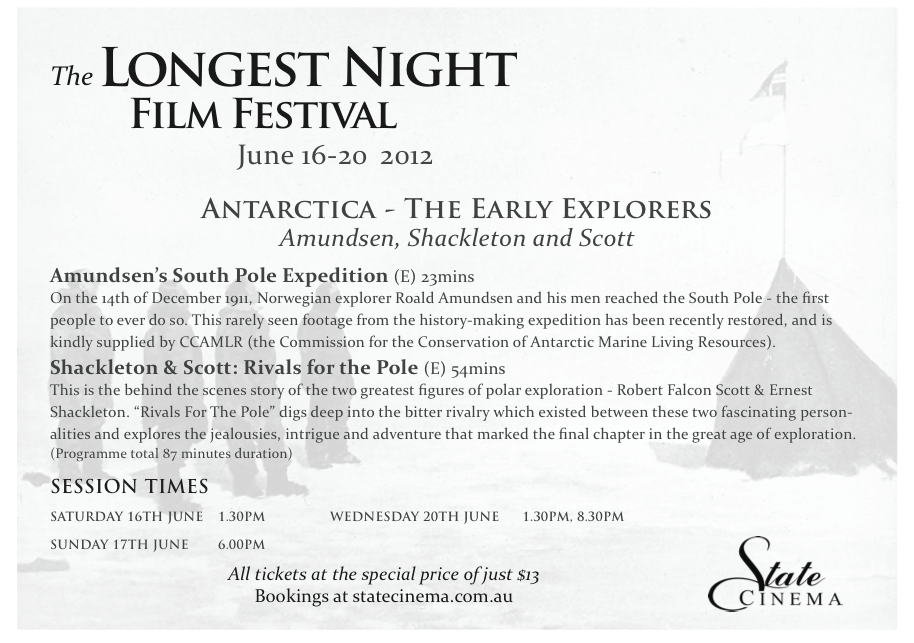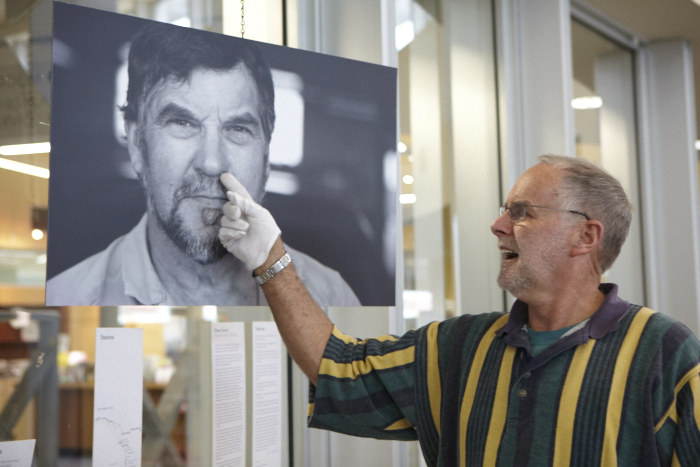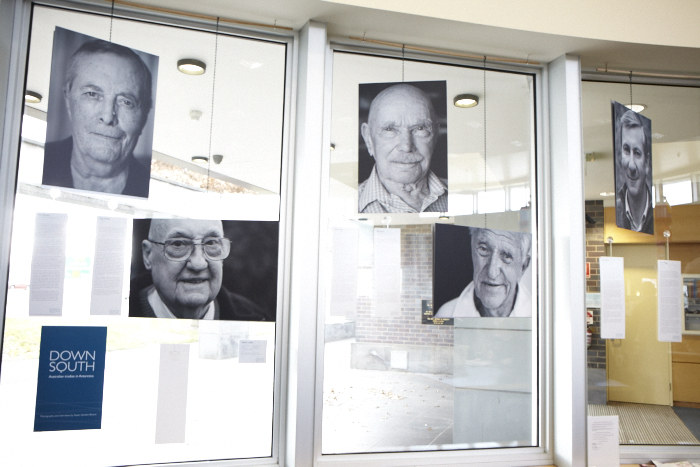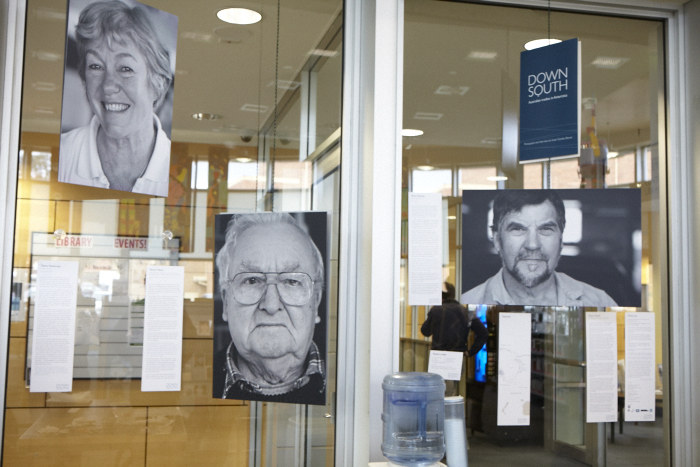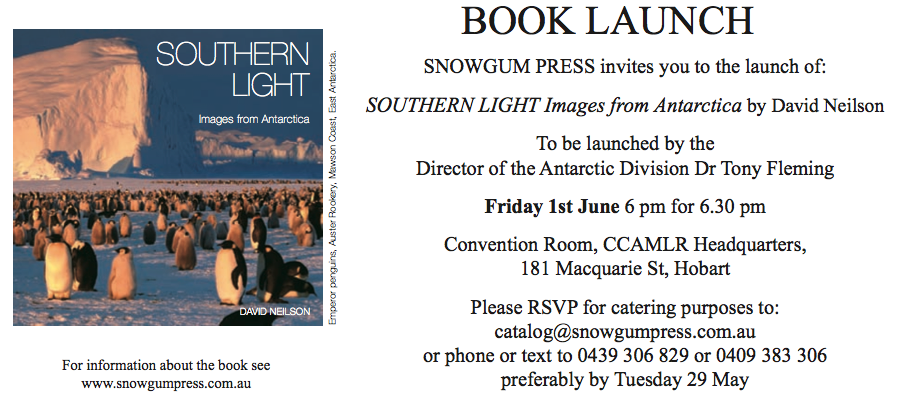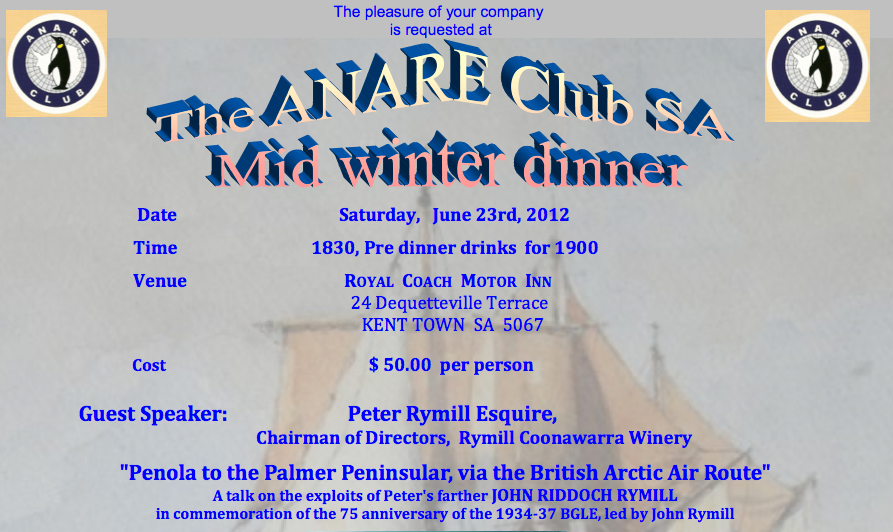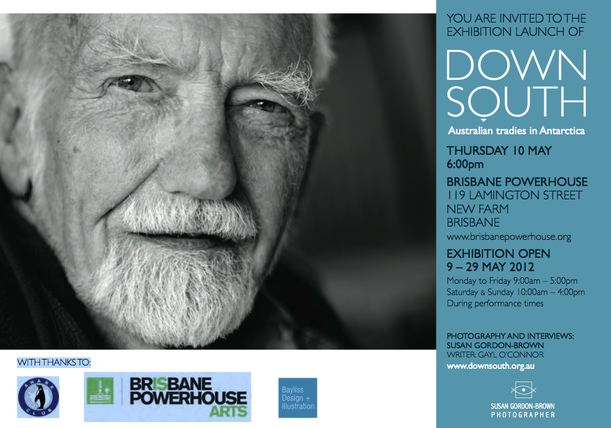|
Latest News
Archives 2012 Ant lake research abandoned
Ant machinery photographic exhibition And furthermore... Queen Elizabeth land announced ...And the Argentinians object.. Ant marine park on ice Nella Dan link Arts recipient Sea ice delays voyage SIPEX 3D map of Ant sea ice New Pres elected Antarctic marine park a step closer Philip Law lecture 2012 ANARE photo auction Nat Geographic auction Tas govt press release Tas branch AGM SIPEX 2 update Ant stories wanted Terra Nova wreck found Fiennes plans winter Antarctic trek AAD magazine on Mawson Quilty at Scott Polar Institute SIPEX 2 update New Antarctic book by Day Macca book wins award |
Antarctic lake research abandoned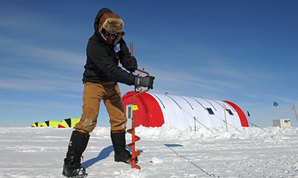
Speaking to the Guardian from Antarctica, Prof Martin Siegert of the University of Edinburgh said he made the "sad decision" to halt the project in the early hours of Christmas Day, after the drilling did not go according to plan. He said the scientists remained committed to the project, however, and would return to complete the job, though that might take at least four or five years. "You don't do this kind of research without thinking about the risks involved," he said. "It is the cutting edge of science." Scientists from the British Antarctic Survey flew to the site above Lake Ellsworth on the West Antarctic ice sheet in early December, joining a team of engineers who had already set up camp with the drilling equipment. They planned to use a hot-water "drill" to cut through the ice cap and sample the contents of the lake, which is liquid because of the extreme pressure of the ice on top of it. By looking for any forms of life in the water, which has been cut off from the rest of the world for anything up to a million years, they hoped to find clues about the evolution of life on Earth and, perhaps, the possibility of life on other planets.An ambitious British plan to search for minute forms of life in an ancient lake beneath Antarctica's ice has been suspended due to technical problems. In a move that clears the way for US and Russian teams to take the lead, Professor Martin Siegert said technical problems and a lack of fuel had forced the closure on Christmas Day of the 7-million-pound project, which was looking for life forms and climate change clues in the lake-bed sediment. "This is of course, hugely frustrating for us, but we have learned a lot this year," said Siegert of the University of Bristol, principal investigator for the mission, which was headed by the British Antarctic Survey (BAS). "By the end, the equipment was working well, and much of it has now been fully field-tested," he said on the BAS website. Experts from Britain's Lake Ellsworth mission had expected to find minute forms of life in the lake three km (two miles) under Antarctica's ice, the most remote and extreme environment known on Earth. They had also hoped that by dating bits of seashell found in the water they would have been able to ascertain when the ice sheet last broke up and to better understand the risks of it happening again. Read more.... Antarctic machinery photographic exhibition
Long recognised as a major figure in New Zealand photography, Wellington-based Anne Noble is an internationally renowned artist. Noble's work ranges from her well-known romantic 1982 essay exploring the Whanganui River to a graceful photo essay about the contemplative life of nuns, to photographs of her daughter Ruby and most recently to an exploration of the notion of the Antarctic.
A recent series on Scott Base machinery, particularly focusing on the names (usually female) of various tractors and trucks is being shown at the Stills photography gallery in Paddington, Sydney and can be accessed here... Any stories /photos of Australian Antarctic /subantarctic machinery, especially the origin of the names and murals welcome... if we get a few we'll do a page on them... |
And furthermore...

And Stills Gallery has just uploaded photographer Anna Nobles latest Antarctic series from her Scott base visit. Entitled 'Piss Poles', they are pretty self explanatory...and an unusual addition to any Antarctic Art collection....
Swathe of Antarctica renamed after Queen Elizabeth
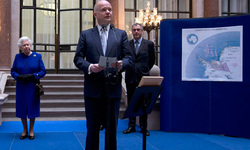
Foreign secretary William Hague announces new name.
- Jerry Brotton
- guardian.co.uk, Wednesday 19 December 2012
- Jerry Brotton
In the old days, the British empire could name huge swaths of Africa, North America or south Asia after any number of dodgy explorers and troubled aristocrats. Now the government is reduced to presenting the Queen with an uninhabited, icy desert twice the size of the UK; the only colonies here are not those of grateful subjects, but penguins and seals. As if to counter charges that this wasn't your average Christmas present, someone in the cabinet came up with the bright idea of also giving the Queen 60 placemats showing views of Buckingham Palace, the kitschness of which would make my own mother blush.
Behind all this lies a more serious point. Look at any political world map from virtually any era and you'll see how all cultures (and not just Europeans) try to impose their authority on places by naming them in their own image. From America (named after the Florentine explorer Amerigo Vespucci) to Rhodesia (created by Cecil Rhodes before it became Zimbabwe), even Greenland (from the Old Norse, and still part of the Danish kingdom), a world map offers a historical lesson in empire, warfare and colonisation just within its toponymy. The naming of Queen Elizabeth Land isn't new, but it comes at a very different moment in the history of empire. In this instance, it does not affect an indigenous people who find an alien name imposed on their land. The Foreign Office also justified its decision by saying "a currently unnamed area requires a name for scientific or logistical purposes", and that this is in line with the Antarctic treaty of 1959, which froze (to forgive the pun) competing claims to the region, making it the first truly "globalised" continent.
Today, more than 75% of Antarctica faces land and territorial claims made by Argentina, Australia, Chile, France, New Zealand, Norway, and the United Kingdom, many of which overlap, while Russia and the United States still reserve the right to make future claims. With fewer than half the world's maritime boundaries agreed according to international law, and the commercial possibilities of mining the natural resources of both the North and South Poles still to be explored, it is no wonder the Foreign Office is getting in there quickly, combining a shrewd jubilee celebration with a claim to future prospecting in a region where it has longstanding interests in claiming control over the seabed. The move will be seen as a particular provocation by Chile and Argentina, who already contest the British Antarctic Territory.
The government needs to tread carefully to avoid this becoming yet another PR gaffe. The name Queen Elizabeth Land will now be used on all British maps, but nobody else is required to adopt it, and undoubtedly few will do so. Just putting your ruler's name on the map won't do these days: it needs political and economic backing, and in today's globalised, trans-national world, it's unclear if Britain will have the authority to make this new name stick. The Queen should also bear in mind the fate that often awaits those who allow a place to be named after them. When her predecessor, the "Virgin Queen", Queen Elizabeth I allowed one of her most cherished attributes to be used in naming a rather more famous region than Antarctica, it came back to bite the British authorities in the American wars of independence. The place was called Virginia.
Reference: read here
Argentina complains to UK over QE Land 'imperialism'
The note handed over by the foreign ministry to John Freeman in Buenos Aires criticised the UK's "anachronistic imperialist ambitions that hark back to ancient practices".
The newly named area has long been claimed by Argentina as its own, along with other contested areas in the south Atlantic including the Falkland Islands, which Argentina claims as Las Malvinas.
The note expressed Argentina's "firmest rejection of the recently announced pretension of the government of the United Kingdom of Great Britain and Northern Ireland of naming an area of the Argentine Antarctic sector".
The ministry accused London of infringing the spirit of the Antarctic treaty, signed in 1959 in Washington DC by 50 nations including Britain and Argentina to preserve the Antarctic from territorial disputes by guaranteeing freedom of scientific investigation and banning military activity on the continent.
Two days ago Argentina's senate unanimously rejected the territory's new name. Read more...
- Uki Goni in Buenos Aires
- guardian.co.uk, Friday 21 December 2012
The note handed over by the foreign ministry to John Freeman in Buenos Aires criticised the UK's "anachronistic imperialist ambitions that hark back to ancient practices".
The newly named area has long been claimed by Argentina as its own, along with other contested areas in the south Atlantic including the Falkland Islands, which Argentina claims as Las Malvinas.
The note expressed Argentina's "firmest rejection of the recently announced pretension of the government of the United Kingdom of Great Britain and Northern Ireland of naming an area of the Argentine Antarctic sector".
The ministry accused London of infringing the spirit of the Antarctic treaty, signed in 1959 in Washington DC by 50 nations including Britain and Argentina to preserve the Antarctic from territorial disputes by guaranteeing freedom of scientific investigation and banning military activity on the continent.
Two days ago Argentina's senate unanimously rejected the territory's new name. Read more...
Fiennes sets off on Antarctic challenge

from website Western Daily Press
31st December 2012.
Veteran explorer Sir Ranulph Fiennes set off on a gruelling Antarctic challenge on Saturday – but was more worried about missing his daughter’s birthday.
He and his five-man team hope to become the first to cross the continent during the polar winter, in temperatures plummeting to minus 90C.But he will be leaving behind his only child, six-year-old Elizabeth during the six-month expedition and will miss her seventh birthday in April.
Exmoor-based Sir Ranulph, who was childless until he met his second wife Louise, said: “My late wife was usually the radio operator on my previous expeditions but when I re-married when she died seven years ago, we had a daughter so this will be the first expedition where I’m away from a child and my 18-year-old step-son.”
He does not yet know if he will be able to contact his family and said he had left presents for Elizabeth’s birthday.
He flew out on Saturday to join the SA Agulhas, the team’s ship, in Cape Town, South Africa.
The journey across the Antarctic has never before been attempted during the polar winter but a Norwegian exploring team recently crossed the Arctic during the summer months.
At 68, Sir Ranulph, who was educated at Sandroyd School, Wiltshire, is the oldest explorer to attempt the crossing and has been described by The Guinness Book of Records as “the world’s greatest living explorer”. He was the first person to visit both poles by surface and the first to cross Antarctica on foot.
He said: “In the last moment before certain expeditions there is a feeling like in the old days of not wanting to go back to school.”
In March 2013 the Ice Team, as they are known, will set off to travel 2,000 miles across the Antarctic, mostly in complete darkness and in temperatures averaging minus 70C.
During their sea voyage, the team will undertake a number of scientific tasks to provide unique data on marine life, oceanography and meteorology.
They will be using the very latest technological innovations such as transportable medical imaging machines, but these have never been tested in such severe winter conditions.
Sir Ranulph explained: “I’m particularly worried about the welding on the tracks. We are not entirely sure when they are under strain.
“We’ll need to carry a lot of food and fuel for a year for six people.”
The Ice Team includes Brian Newham, 54, a British mountaineer; Spencer Smirl, 28, a mechanic from Canada; Ian Prickett, 34, an engineer from Hampshire; Richmond Dykes, 30, an engineer from Northern Ireland and Dr Robert Lambert, from Cumbria.
The expedition aims to raise $10 million (£6.17 million) for Seeing is Believing, a charitable initiative tackling preventable blindness across the globe.
31st December 2012.
Veteran explorer Sir Ranulph Fiennes set off on a gruelling Antarctic challenge on Saturday – but was more worried about missing his daughter’s birthday.
He and his five-man team hope to become the first to cross the continent during the polar winter, in temperatures plummeting to minus 90C.But he will be leaving behind his only child, six-year-old Elizabeth during the six-month expedition and will miss her seventh birthday in April.
Exmoor-based Sir Ranulph, who was childless until he met his second wife Louise, said: “My late wife was usually the radio operator on my previous expeditions but when I re-married when she died seven years ago, we had a daughter so this will be the first expedition where I’m away from a child and my 18-year-old step-son.”
He does not yet know if he will be able to contact his family and said he had left presents for Elizabeth’s birthday.
He flew out on Saturday to join the SA Agulhas, the team’s ship, in Cape Town, South Africa.
The journey across the Antarctic has never before been attempted during the polar winter but a Norwegian exploring team recently crossed the Arctic during the summer months.
At 68, Sir Ranulph, who was educated at Sandroyd School, Wiltshire, is the oldest explorer to attempt the crossing and has been described by The Guinness Book of Records as “the world’s greatest living explorer”. He was the first person to visit both poles by surface and the first to cross Antarctica on foot.
He said: “In the last moment before certain expeditions there is a feeling like in the old days of not wanting to go back to school.”
In March 2013 the Ice Team, as they are known, will set off to travel 2,000 miles across the Antarctic, mostly in complete darkness and in temperatures averaging minus 70C.
During their sea voyage, the team will undertake a number of scientific tasks to provide unique data on marine life, oceanography and meteorology.
They will be using the very latest technological innovations such as transportable medical imaging machines, but these have never been tested in such severe winter conditions.
Sir Ranulph explained: “I’m particularly worried about the welding on the tracks. We are not entirely sure when they are under strain.
“We’ll need to carry a lot of food and fuel for a year for six people.”
The Ice Team includes Brian Newham, 54, a British mountaineer; Spencer Smirl, 28, a mechanic from Canada; Ian Prickett, 34, an engineer from Hampshire; Richmond Dykes, 30, an engineer from Northern Ireland and Dr Robert Lambert, from Cumbria.
The expedition aims to raise $10 million (£6.17 million) for Seeing is Believing, a charitable initiative tackling preventable blindness across the globe.
HEAT telescope observes star-making clouds

from the Antarctic Sun website
The HEAT (High elevation Antarctic terahertz) telescope has been installed at Ridge A about 900 kilometers from South Pole station in a joint Australian /US initiative.
At around 4,100 meters in altitude, and a dry atmosphere, Ridge A provides ideal conditions for looking at the molecular clouds in space.
The three-mirror telescope focuses light to a small cryostat that holds detectors cooled to 50 Kelvin (minus 370 degrees Fahrenheit). The terahertz telescope observes molecular clouds where stars are made.
The telescope “tunes” into frequencies between 0.5 and 2 THz, about 1,000 times higher than a mobile phone or 10,000 times higher than a typical two-way radio. Read more...
posted 21/12/2012
The HEAT (High elevation Antarctic terahertz) telescope has been installed at Ridge A about 900 kilometers from South Pole station in a joint Australian /US initiative.
At around 4,100 meters in altitude, and a dry atmosphere, Ridge A provides ideal conditions for looking at the molecular clouds in space.
The three-mirror telescope focuses light to a small cryostat that holds detectors cooled to 50 Kelvin (minus 370 degrees Fahrenheit). The terahertz telescope observes molecular clouds where stars are made.
The telescope “tunes” into frequencies between 0.5 and 2 THz, about 1,000 times higher than a mobile phone or 10,000 times higher than a typical two-way radio. Read more...
posted 21/12/2012
Centenary of Ninnis death
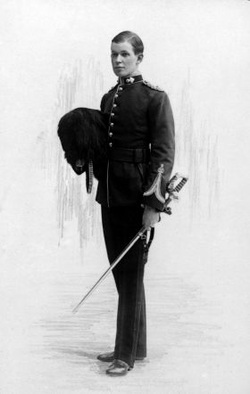
from Australian Antarctic Division website
Today, Friday 14 December 2012, marks 100 years since the death of Douglas Mawson’s sledging companion, Lieutenant Belgrave Edward Sutton Ninnis.
Ninnis was a Lieutenant in the Royal Fusiliers, an infantry regiment in the British Army, before he joined Mawson’s 1911-1914 Australasian Antarctic Expedition as a minder of the 49 Greenland huskies that would be used for sledging in Antarctica.
Ninnis was part of the three-man sledging team, the 'Far Eastern Party', with Douglas Mawson and Xavier Mertz, who headed east on 10 November 1912 to survey King George V Land.
After three weeks of excellent progress the party was crossing a glacier (now known as the Ninnis Glacier), when Ninnis fell through a snow-covered crevasse. Mertz had skied over the crevasse lid, Mawson had been on his sled with his weight dispersed, but Ninnis was jogging beside the second sled and his body weight is likely to have breached the lid.
Six of the best dogs, most of the party's rations, their tent and other essential supplies disappeared into a massive crevasse 480 km east of the main base. Mertz and Mawson spotted one dead and one injured dog on a ledge 46 m down, but Ninnis was never seen again. He was 25 years old. Read more...
Today, Friday 14 December 2012, marks 100 years since the death of Douglas Mawson’s sledging companion, Lieutenant Belgrave Edward Sutton Ninnis.
Ninnis was a Lieutenant in the Royal Fusiliers, an infantry regiment in the British Army, before he joined Mawson’s 1911-1914 Australasian Antarctic Expedition as a minder of the 49 Greenland huskies that would be used for sledging in Antarctica.
Ninnis was part of the three-man sledging team, the 'Far Eastern Party', with Douglas Mawson and Xavier Mertz, who headed east on 10 November 1912 to survey King George V Land.
After three weeks of excellent progress the party was crossing a glacier (now known as the Ninnis Glacier), when Ninnis fell through a snow-covered crevasse. Mertz had skied over the crevasse lid, Mawson had been on his sled with his weight dispersed, but Ninnis was jogging beside the second sled and his body weight is likely to have breached the lid.
Six of the best dogs, most of the party's rations, their tent and other essential supplies disappeared into a massive crevasse 480 km east of the main base. Mertz and Mawson spotted one dead and one injured dog on a ledge 46 m down, but Ninnis was never seen again. He was 25 years old. Read more...
Antarctic marine park on ice
by Matthew Denholm, Tasmanian Correspondent
published in The Australian Newspaper and online
3rd November 2012.
PLANS by Australia, the United States and other Antarctic nations to create the world's biggest marine parks, in the Southern Ocean, have been blocked by Russia and China but will be considered again next year.
The global body charged with conserving Antarctic marine life, meeting in Hobart, failed to adopt two plans for the planet's largest marine protected areas (MPAs) covering more than 4 million square kilometres of ocean.
While the proponents - Australia and France, and the United States and New Zealand - apparently secured majority support, the historic move was blocked by China, Russia and the Ukraine late last night.
The 25-member Commission for the Conservation of Marine Living Resources (CCAMLR) makes decisions by consensus only, meaning the proposals were defeated with the effective veto of Russia and China. Australia's head of delegation, Tony Fleming, joined other nations in expressing disappointment at the decision, which followed 12 months of work and two weeks of deliberations. Their hopes now turn to a special summit on the issue that CCAMLR has agreed to hold in Germany in July next year.
However, there are concerns China and Russia will continue to play a spoiler role, despite CCAMLR having previously resolved to create a network of Antarctic MPAs by the end of this year.
"This year, CCAMLR has behaved like a fisheries organisation instead of an organisation dedicated to conservation of Antarctic waters," said Farah Obaidullah of Greenpeace.
by Matthew Denholm, Tasmanian Correspondent
published in The Australian Newspaper and online
3rd November 2012.
PLANS by Australia, the United States and other Antarctic nations to create the world's biggest marine parks, in the Southern Ocean, have been blocked by Russia and China but will be considered again next year.
The global body charged with conserving Antarctic marine life, meeting in Hobart, failed to adopt two plans for the planet's largest marine protected areas (MPAs) covering more than 4 million square kilometres of ocean.
While the proponents - Australia and France, and the United States and New Zealand - apparently secured majority support, the historic move was blocked by China, Russia and the Ukraine late last night.
The 25-member Commission for the Conservation of Marine Living Resources (CCAMLR) makes decisions by consensus only, meaning the proposals were defeated with the effective veto of Russia and China. Australia's head of delegation, Tony Fleming, joined other nations in expressing disappointment at the decision, which followed 12 months of work and two weeks of deliberations. Their hopes now turn to a special summit on the issue that CCAMLR has agreed to hold in Germany in July next year.
However, there are concerns China and Russia will continue to play a spoiler role, despite CCAMLR having previously resolved to create a network of Antarctic MPAs by the end of this year.
"This year, CCAMLR has behaved like a fisheries organisation instead of an organisation dedicated to conservation of Antarctic waters," said Farah Obaidullah of Greenpeace.
Arts fellowship recipient to feature Nella Dan

from AAD website
The 2012 Australian Antarctic Arts Fellowship has been awarded to Australian writer Favel Parrett.
Each year, the Australian Government awards an Arts Fellowship to enable outstanding applicants with a non-science focus to experience Antarctica first-hand so that they may communicate this unique experience and understanding to other Australians.
The Director of the Australian Antarctic Division, Dr Tony Fleming, said Ms Parrett would use the Fellowship to research a novel based on the Nella Dan, a supply ship that was used by the Australian Antarctic Division for 26 years.
“The Nella Dan’s service record remains unchallenged as Australia’s longest continuously serving Antarctic ship,” Dr Fleming said.
“This year marks the 25th anniversary of her scuttling off Macquarie Island, and Favel’s novel will draw attention to Australia’s rich Antarctic history and the Nella Dan’s role.
“The Nella Dan visited every one of Australia’s Antarctic stations several times, and supported major exploratory activities along much of the Eastern Antarctic coastline.
“From 1981, she continued to provide a research platform for Australia’s increasingly sophisticated and prestigious marine science program.
“Through this Fellowship, Favel will get the opportunity to experience first-hand what it is like to travel on a working polar and marine science vessel, visiting one of the stations and the areas that Nella Dan worked in.”
Favel Parrett, from Carlton, in Victoria, will travel to Antarctica on Australia’s current icebreaker Aurora Australis, leaving Hobart on 7 November. She will visit Australia’s Davis station before returning in early December.
Ms Parrett grew up in Hobart, and knew the Nella Dan well as a child – even keeping a photo of the ship at Heard Island on her bedroom wall. She has already interviewed many past crew and expeditioners who travelled on the Nella Dan as research for her book.
Ms Parrett was a recipient of an Australian Society of Authors Mentorship in 2009 and has had a number of short stories published in journals including Island, Wet Ink, Griffith Review and Best Australian Stories 2011.
Her first novel, Past the Shallows, was shortlisted for the Miles Franklin Literary award 2012 and also won the Dobbie Literary Prize and Newcomer of the Year at the Australian Book Industry Awards.
More information
Australian Antarctic Division Arts Fellowship
The 2012 Australian Antarctic Arts Fellowship has been awarded to Australian writer Favel Parrett.
Each year, the Australian Government awards an Arts Fellowship to enable outstanding applicants with a non-science focus to experience Antarctica first-hand so that they may communicate this unique experience and understanding to other Australians.
The Director of the Australian Antarctic Division, Dr Tony Fleming, said Ms Parrett would use the Fellowship to research a novel based on the Nella Dan, a supply ship that was used by the Australian Antarctic Division for 26 years.
“The Nella Dan’s service record remains unchallenged as Australia’s longest continuously serving Antarctic ship,” Dr Fleming said.
“This year marks the 25th anniversary of her scuttling off Macquarie Island, and Favel’s novel will draw attention to Australia’s rich Antarctic history and the Nella Dan’s role.
“The Nella Dan visited every one of Australia’s Antarctic stations several times, and supported major exploratory activities along much of the Eastern Antarctic coastline.
“From 1981, she continued to provide a research platform for Australia’s increasingly sophisticated and prestigious marine science program.
“Through this Fellowship, Favel will get the opportunity to experience first-hand what it is like to travel on a working polar and marine science vessel, visiting one of the stations and the areas that Nella Dan worked in.”
Favel Parrett, from Carlton, in Victoria, will travel to Antarctica on Australia’s current icebreaker Aurora Australis, leaving Hobart on 7 November. She will visit Australia’s Davis station before returning in early December.
Ms Parrett grew up in Hobart, and knew the Nella Dan well as a child – even keeping a photo of the ship at Heard Island on her bedroom wall. She has already interviewed many past crew and expeditioners who travelled on the Nella Dan as research for her book.
Ms Parrett was a recipient of an Australian Society of Authors Mentorship in 2009 and has had a number of short stories published in journals including Island, Wet Ink, Griffith Review and Best Australian Stories 2011.
Her first novel, Past the Shallows, was shortlisted for the Miles Franklin Literary award 2012 and also won the Dobbie Literary Prize and Newcomer of the Year at the Australian Book Industry Awards.
More information
Australian Antarctic Division Arts Fellowship
Sea ice delays voyage
from Australian Antarctic Division website
Australia’s ice breaker Aurora Australis remains in heavy sea ice off East Antarctica delaying the ship’s return to Hobart.
The research and resupply vessel was due to arrive back in port on the 5 November, but this has been delayed by at least one day.
The Aurora Australis current position is 1600 nautical miles south-west of Hobart, 80 nm from the Antarctic Coast and about 200 nm from Australia’s Casey station.
It’s hoped the weather will break up some of the ice around the ship and allow it to reach open water.
The scientists on board are undertaking a major sea ice research voyage, collecting a range of data using underwater vehicles and helicopters.
The delay will mean the next voyage to Davis station will also be pushed back until 9 November at the earliest.
Australia’s ice breaker Aurora Australis remains in heavy sea ice off East Antarctica delaying the ship’s return to Hobart.
The research and resupply vessel was due to arrive back in port on the 5 November, but this has been delayed by at least one day.
The Aurora Australis current position is 1600 nautical miles south-west of Hobart, 80 nm from the Antarctic Coast and about 200 nm from Australia’s Casey station.
It’s hoped the weather will break up some of the ice around the ship and allow it to reach open water.
The scientists on board are undertaking a major sea ice research voyage, collecting a range of data using underwater vehicles and helicopters.
The delay will mean the next voyage to Davis station will also be pushed back until 9 November at the earliest.
SIPEX II produces first 3D map of Antarctic sea ice
from SCAR website
Scientists from eight countries (Australia, Belgium, Canada, France, Germany, Japan, New Zealand and the United States) have created the first detailed 3D map of the underside of sea ice in Antarctica.
Working aboard the Australian Antarctic Division's Aurora Australis under SIPEX II (the 2nd Sea Ice Physics and Ecosystem eXperiment, a long-term mission to map Antarctic sea ice), the team deployed an autonomous underwater vehicle (AUV) to map the topography of the ice from below. Using multibeam sonar, the robot submarine was able to create a clear picture of the inverted 'mountains and valleys' in the sea ice, giving a clearer picture of its volume and thickness.
By combining this with data from satellites and helicopter surveys, the scientists are getting a better understanding how the sea ice is changing over time due to the changing climate. This in turn will give insight into how climate change is affecting not only the sea ice and the ocean, but also the ecosystems influenced by sea ice and the biota that inhabit them. Changes in sea ice thickness also influence the formation of cold, salty Antarctic bottom water, which drives the global thermohaline circulation and influences global climate.
For more details, watch the video on youtube or read the news item on the Australian Antarctic Division's website.
from SCAR website
Scientists from eight countries (Australia, Belgium, Canada, France, Germany, Japan, New Zealand and the United States) have created the first detailed 3D map of the underside of sea ice in Antarctica.
Working aboard the Australian Antarctic Division's Aurora Australis under SIPEX II (the 2nd Sea Ice Physics and Ecosystem eXperiment, a long-term mission to map Antarctic sea ice), the team deployed an autonomous underwater vehicle (AUV) to map the topography of the ice from below. Using multibeam sonar, the robot submarine was able to create a clear picture of the inverted 'mountains and valleys' in the sea ice, giving a clearer picture of its volume and thickness.
By combining this with data from satellites and helicopter surveys, the scientists are getting a better understanding how the sea ice is changing over time due to the changing climate. This in turn will give insight into how climate change is affecting not only the sea ice and the ocean, but also the ecosystems influenced by sea ice and the biota that inhabit them. Changes in sea ice thickness also influence the formation of cold, salty Antarctic bottom water, which drives the global thermohaline circulation and influences global climate.
For more details, watch the video on youtube or read the news item on the Australian Antarctic Division's website.
And the winner is...New Tas Branch president elected!!!

Jan Adolph by Susan Gordon Brown
Jan Adolph was elected president of the ANARE Club Tas branch at our recent AGM. The current council includes:
President: Jan Adolph
Treasurer: Michael Ooyendyk
Social Secretary: Marilyn Boydell/ Michael Carr
Webmistress: Ingrid Mcgaughey
General Council member: George Cresswell
Jan writes...
'I have been a member of the ANARE Club since 1984. I wintered as an electrician at Davis in 1982 and Macca in 1984. After returning from Macca I commenced full time at AAD. I have spent a number of summers down south since then and I’ve also been on a few round trips. I have visited all the stations plus Commonwealth Bay. I am currently planning to travel to Heard Island.
I look forward to working with our Tasmanian members to get next year’s Midwinter Dinner organized and being another successful event.
Thanks to Noel Barrett and the previous committee for all their hard work over the last couple of years...'
President: Jan Adolph
Treasurer: Michael Ooyendyk
Social Secretary: Marilyn Boydell/ Michael Carr
Webmistress: Ingrid Mcgaughey
General Council member: George Cresswell
Jan writes...
'I have been a member of the ANARE Club since 1984. I wintered as an electrician at Davis in 1982 and Macca in 1984. After returning from Macca I commenced full time at AAD. I have spent a number of summers down south since then and I’ve also been on a few round trips. I have visited all the stations plus Commonwealth Bay. I am currently planning to travel to Heard Island.
I look forward to working with our Tasmanian members to get next year’s Midwinter Dinner organized and being another successful event.
Thanks to Noel Barrett and the previous committee for all their hard work over the last couple of years...'
CCAMLR meeting now on in Hobart

from CCAMLR website
Milestone discussions on marine protected areas in Antarctica scheduled for CCAMLR’s 31st annual meetings in Hobart
The flags of twenty-five Members are again flying on Macquarie Street, Hobart, as CCAMLR welcomes 200 marine scientists, natural resource managers, marine policy makers and diplomats. Experts from around the world will meet from Monday 8 October to Thursday 1 November to hold a series of scientific and policy discussions that mark the 31st annual meetings of the Commission.
This year CCAMLR’s meetings will concentrate on establishing a representative system of marine protected areas in the Southern Ocean. Over the last seven years, CCAMLR’s Members have identified several regions of the Southern Ocean that warrant high levels of protection. These important areas can provide a reference for scientific research on the impacts of activities such as fishing, as well as significant opportunities for monitoring the impacts of climate change in the Southern Ocean.
Milestone discussions on marine protected areas in Antarctica scheduled for CCAMLR’s 31st annual meetings in Hobart
The flags of twenty-five Members are again flying on Macquarie Street, Hobart, as CCAMLR welcomes 200 marine scientists, natural resource managers, marine policy makers and diplomats. Experts from around the world will meet from Monday 8 October to Thursday 1 November to hold a series of scientific and policy discussions that mark the 31st annual meetings of the Commission.
This year CCAMLR’s meetings will concentrate on establishing a representative system of marine protected areas in the Southern Ocean. Over the last seven years, CCAMLR’s Members have identified several regions of the Southern Ocean that warrant high levels of protection. These important areas can provide a reference for scientific research on the impacts of activities such as fishing, as well as significant opportunities for monitoring the impacts of climate change in the Southern Ocean.
Antarctic marine park a step closer...

PLANS for the world's biggest marine park, in Antarctica, have received a significant boost after the US and New Zealand resolved a major split on the issue.
The two nations had been divided on the plan for the Ross Sea -- largely over the issue of New Zealand's harvest of Antarctic toothfish -- but have now agreed a common proposal covering 2.27 million square kilometres.
The deal -- allowing "light" fishing rather than banning it altogether in a key New Zealand toothfishing ground -- dramatically increases the prospects of the world body for Antarctic marine life accepting the move.
US and New Zealand negotiators told The Australian yesterday that the compromise -- news of which was broken by The Australian online -- included a 1.6 million sq km "no take" zone where fishing would be banned.
Without a joint proposal, it had been expected that the Commission for the Conservation of Marine Living Resources, meeting in Hobart, would fail to reach agreement on a marine park for the Ross Sea, south of New Zealand.
The joint plan means an outcome is far more likely, although not guaranteed, while the future of a joint Australian-French plan for a 1.9 million sq kilometre marine park in East Antarctica also hangs in the balance.
The stand-off between the US and New Zealand had reached the highest levels, with US Secretary of State Hillary Clinton pushing for a resolution and New Zealand sending senior diplomat Gerard van Bohemen to the CCAMLR summit.
A final decision is expected late this week.
"We now have to get everyone else on board and that process has begun in earnest," US Ocean and Polar Affairs director Evan Bloom told The Australian. New Zealand negotiator Carolyn Schwalger said the compromise with the US on the Ross Sea marine park would not reduce her country's $14 million a year toothfish harvest.
"None of the marine park area proposals are about reducing fishing; they are all about moving fishing into areas that will have less of a negative impact on the wider ecosystem," she said.
The two nations still appear divided on whether the giant marine park should have a sunset clause, beyond an agreed 10-year review.
CCAMLR delegates heard an emotional plea in favour of a Ross Sea marine reserve from the great, great, great granddaughter of 19th century explorer James Clark Ross, after whom the area is named.
Philippa Ross urged delegates to "show the same courage and resilience" as her forebear.
"This is your last chance to save the last ocean," she said.
posted 31/10/2012
Pat Quilty gives 2012 Philip Law lecture

Details have been scarce...Little publicity was provided by the organisers of the Philip Law lecture much to our disappointment so many ANARE folk missed the opportunity to attend the presentation in August 2012.
Invited speaker Patrick Quilty , ANARE Club member, former Chief Scientist of the Australian Antarctic Division, and now Honorary Research Professor in Earth Sciences at the Institute for Marine and Antarctic Studies (IMAS) at the University of Tasmania, gave a great presentation on Tasmania's Antarctic connections.
From the earliest days of European settlement, Hobart in Southern Tasmania has seen a long line of explorers and scientists depart for Antarctica. Biscoe and Weddell, Dumont d’Urville, Ross, Borchgrevink, Mawson and Amundsen all used Hobart as a jumping-off point. The Australian Antarctic Division moved here in 1981, confirming the city’s Antarctic culture and community. The Antarctic connection is more important to Tasmania than ever before, but his presentation pondered whether Tasmania would maintain and further develop that role.
The Phillip Law Lecture honours the lifetime achievements of the first director of the Australian National Antarctic Research Expeditions (ANARE).
Invited speaker Patrick Quilty , ANARE Club member, former Chief Scientist of the Australian Antarctic Division, and now Honorary Research Professor in Earth Sciences at the Institute for Marine and Antarctic Studies (IMAS) at the University of Tasmania, gave a great presentation on Tasmania's Antarctic connections.
From the earliest days of European settlement, Hobart in Southern Tasmania has seen a long line of explorers and scientists depart for Antarctica. Biscoe and Weddell, Dumont d’Urville, Ross, Borchgrevink, Mawson and Amundsen all used Hobart as a jumping-off point. The Australian Antarctic Division moved here in 1981, confirming the city’s Antarctic culture and community. The Antarctic connection is more important to Tasmania than ever before, but his presentation pondered whether Tasmania would maintain and further develop that role.
The Phillip Law Lecture honours the lifetime achievements of the first director of the Australian National Antarctic Research Expeditions (ANARE).
ANARE photographs auctioned

File image of Macquarie Island from AAD.
The TV series Auction Room is covering the sale of some ANARE memorabilia and photographs this week.
Hosted by antiques dealer and expert Gordon Brown, formerly of ABC TV’s popular program Collectors, Auction Room airs on ABC1 on Sundays at 6.00pm.
In the series the always entertaining Gordon meets a range of intriguing personalities with fascinating stories to tell about the treasured possessions they’re selling at auction.
This Sunday 4th November the episode features Aurora editor John Gillies being interviewed as a collection of ANARE photographs from Heard and Macquarie Island come up for auction. John thought the photographs most likely were sourced from Don Cubit's collection. Don was the victualling officer /crewman on the LST 3501, later the Labuan.
posted 31/10/12
Hosted by antiques dealer and expert Gordon Brown, formerly of ABC TV’s popular program Collectors, Auction Room airs on ABC1 on Sundays at 6.00pm.
In the series the always entertaining Gordon meets a range of intriguing personalities with fascinating stories to tell about the treasured possessions they’re selling at auction.
This Sunday 4th November the episode features Aurora editor John Gillies being interviewed as a collection of ANARE photographs from Heard and Macquarie Island come up for auction. John thought the photographs most likely were sourced from Don Cubit's collection. Don was the victualling officer /crewman on the LST 3501, later the Labuan.
posted 31/10/12
National Geographic auctions Antarctic photos
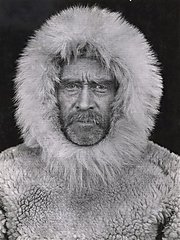
Peary 1908. Photographer unknown
National Geographic Society plans to auction a small selection of their huge archive of over 10 million photographs spanning from the late 1800s to the present at Christie's in December 2012. This is the first time any of the institution's collection has been sold.
Among the items are some of National Geographic's most indelible photographs, including a portrait of Admiral Robert Peary at his 1908 expedition to the North Pole, and a selection of images from Herbert Ponting, which have never been previously published.
The catalogue has not yet been released on line, but should be available on the Christies website in mid November 2012.
Proceeds from the Dec. 6 auction, just weeks before National Geographic's 125th anniversary, will go for the promotion and preservation of the archive and "the nurturing of young photographers, artists and explorers ... who are the future of the organization," Mulvihill, the senior vice president of National Geographic's image and video archives said.
National Geographic sponsors and funds scientific research and exploration through its official journal, National Geographic Magazine, which reaches 8.8 million people worldwide in 36 countries and in 27 languages. The society reaches millions more through its National Geographic Channel, books and other sources.
posted 29/10/2012
Among the items are some of National Geographic's most indelible photographs, including a portrait of Admiral Robert Peary at his 1908 expedition to the North Pole, and a selection of images from Herbert Ponting, which have never been previously published.
The catalogue has not yet been released on line, but should be available on the Christies website in mid November 2012.
Proceeds from the Dec. 6 auction, just weeks before National Geographic's 125th anniversary, will go for the promotion and preservation of the archive and "the nurturing of young photographers, artists and explorers ... who are the future of the organization," Mulvihill, the senior vice president of National Geographic's image and video archives said.
National Geographic sponsors and funds scientific research and exploration through its official journal, National Geographic Magazine, which reaches 8.8 million people worldwide in 36 countries and in 27 languages. The society reaches millions more through its National Geographic Channel, books and other sources.
posted 29/10/2012
Traversing Antarctica exhibition opening in Fremantle
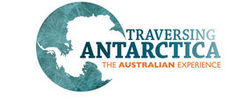
We have received a personal invitation for two people to the opening of traversing Antarctica on Wednesday 7th November 2012. If anyone from Western Australia is interested in attending please contact us ...
Traversing Antarctica highlights Australia's connection with the Antarctic and has been developed by the National Archives of Australia in partnership with the Australian Antarctic Division and Western Australian Museum, with support from the Tasmanian Museum and Art Gallery and South Australian Museum.
The exhibition includes a rare collection of artifacts that are on display together for the first time, among them are original equipment and diaries used by members of the Australasian Antarctic Expedition. The exhibition is interesting as rather than focus predominantly on Sir Douglas Mawson, there is a real attempt to highlight the contribution of other AAE members. One of the most moving exhibits is Stillwell's diary with the sentence '...still no Mawson...'
The exhibition is opening on 3rd November 2012 until 24th February 2013. It will then continue to tour nationally until 2014. The ANARE Club and Pat Quilty were consulted by curator Jane McKnight for expert advice in the development stages of the exhibition (and appreciate being recognised on the exhibition acknowledgements board!) It is pleasing to see a number of large format photographs by ANARE Club member Chris Wilson as well as several hobby items made by ANARE expeditioners in the exhibition.
Where: West Australian Maritime Museum, Fremantle.
When: 3rd November 2012 -24th February 2013
Cost: free
posted 28/10/2012
Traversing Antarctica highlights Australia's connection with the Antarctic and has been developed by the National Archives of Australia in partnership with the Australian Antarctic Division and Western Australian Museum, with support from the Tasmanian Museum and Art Gallery and South Australian Museum.
The exhibition includes a rare collection of artifacts that are on display together for the first time, among them are original equipment and diaries used by members of the Australasian Antarctic Expedition. The exhibition is interesting as rather than focus predominantly on Sir Douglas Mawson, there is a real attempt to highlight the contribution of other AAE members. One of the most moving exhibits is Stillwell's diary with the sentence '...still no Mawson...'
The exhibition is opening on 3rd November 2012 until 24th February 2013. It will then continue to tour nationally until 2014. The ANARE Club and Pat Quilty were consulted by curator Jane McKnight for expert advice in the development stages of the exhibition (and appreciate being recognised on the exhibition acknowledgements board!) It is pleasing to see a number of large format photographs by ANARE Club member Chris Wilson as well as several hobby items made by ANARE expeditioners in the exhibition.
Where: West Australian Maritime Museum, Fremantle.
When: 3rd November 2012 -24th February 2013
Cost: free
posted 28/10/2012
Tas Govt press release re Antarctic research support goals

Thu 27 September 2012
By Premier Lara Giddings and Minister for Economic Development David O'Byrne
Tasmania is perfectly positioned to host Antarctic research vessels from China, with the $7 million redevelopment of Macquarie Wharf Number 2 Shed now underway.
The project will transform the former storage shed into a world-class Antarctic shipping and logistics hub, along with facilities for visiting cruise ships.
The Premier, Lara Giddings, and Minister for Economic Development, David O'Byrne, today inspected progress on the Mac 2 development.
It follows successful meetings with the Chinese Vice Minister for Land and Resources, the head of the Chinese Arctic and Antarctic Administration and the Director-General of the Polar Research Institute of China.
"As a direct result of these meetings I am now optimistic that we will see Chinese research vessels using Hobart as a supply port in the near future," Ms Giddings said.
"This is a big deal because it promotes Tasmania to the world, generates new economic activity and most importantly grows jobs in Tasmania."
Ms Giddings said during the visit the University of Tasmania also explored the potential for research collaborations between the Chinese and the Institute of Marine and Antarctic studies, also under construction on the Hobart Waterfront.
"The Polar Research Institute of China was very impressed with the IMAS development and have indicated enthusiasm to tap into our world class Southern Ocean research."
Mr O'Byrne said the redevelopment of Mac 2 is due to be completed by March next year and would provide vital infrastructure to compliment Tasmania's natural deep port advantage and proximity to the Antarctic region.
The project is being delivered through our Government Business Enterprise Tasports and is being built by Fairbrother, a proud Tasmanian company.
"This project is a win for tourism, Antarctic research, and local construction jobs, all in one," Mr O'Byrne said.
"Demolition work has taken place over the past six weeks, and this exciting redevelopment can now start in earnest. The next phase will see revised traffic arrangements and general construction works - including a new roof.
"This project builds on two massive Tasmanian strengths - our tourism attraction, and world-leading Antarctic sector.
"Hobart has the highest concentration of Antarctic and sub-Antarctic researchers in Australia, and the Government is working strongly with the industry to attract more East Antarctic nations to adopt Hobart as their Antarctic gateway.
"Both tourism and our Antarctic industry are identified as key growth sectors in the Tasmanian Government's Economic Development Plan, which helps find new sustainable markets and create the jobs of tomorrow," he said.
The Tasmanian Government has committed to a $1.5-billion infrastructure program, along with a $2.9-billion program across government businesses.
"Over the Forward Estimates, that amounts to a massive $4.4 billion infrastructure program.
"This is a uniquely exciting time on the Hobart waterfront. We're transforming it into a modern and dynamic place, which attracts people to work, play and live," he said.
By Premier Lara Giddings and Minister for Economic Development David O'Byrne
Tasmania is perfectly positioned to host Antarctic research vessels from China, with the $7 million redevelopment of Macquarie Wharf Number 2 Shed now underway.
The project will transform the former storage shed into a world-class Antarctic shipping and logistics hub, along with facilities for visiting cruise ships.
The Premier, Lara Giddings, and Minister for Economic Development, David O'Byrne, today inspected progress on the Mac 2 development.
It follows successful meetings with the Chinese Vice Minister for Land and Resources, the head of the Chinese Arctic and Antarctic Administration and the Director-General of the Polar Research Institute of China.
"As a direct result of these meetings I am now optimistic that we will see Chinese research vessels using Hobart as a supply port in the near future," Ms Giddings said.
"This is a big deal because it promotes Tasmania to the world, generates new economic activity and most importantly grows jobs in Tasmania."
Ms Giddings said during the visit the University of Tasmania also explored the potential for research collaborations between the Chinese and the Institute of Marine and Antarctic studies, also under construction on the Hobart Waterfront.
"The Polar Research Institute of China was very impressed with the IMAS development and have indicated enthusiasm to tap into our world class Southern Ocean research."
Mr O'Byrne said the redevelopment of Mac 2 is due to be completed by March next year and would provide vital infrastructure to compliment Tasmania's natural deep port advantage and proximity to the Antarctic region.
The project is being delivered through our Government Business Enterprise Tasports and is being built by Fairbrother, a proud Tasmanian company.
"This project is a win for tourism, Antarctic research, and local construction jobs, all in one," Mr O'Byrne said.
"Demolition work has taken place over the past six weeks, and this exciting redevelopment can now start in earnest. The next phase will see revised traffic arrangements and general construction works - including a new roof.
"This project builds on two massive Tasmanian strengths - our tourism attraction, and world-leading Antarctic sector.
"Hobart has the highest concentration of Antarctic and sub-Antarctic researchers in Australia, and the Government is working strongly with the industry to attract more East Antarctic nations to adopt Hobart as their Antarctic gateway.
"Both tourism and our Antarctic industry are identified as key growth sectors in the Tasmanian Government's Economic Development Plan, which helps find new sustainable markets and create the jobs of tomorrow," he said.
The Tasmanian Government has committed to a $1.5-billion infrastructure program, along with a $2.9-billion program across government businesses.
"Over the Forward Estimates, that amounts to a massive $4.4 billion infrastructure program.
"This is a uniquely exciting time on the Hobart waterfront. We're transforming it into a modern and dynamic place, which attracts people to work, play and live," he said.
ANARE CLUB - Tas branch 2012 Annual General Meeting
The Club AGM will now be held at Hadley’s in Murray St, Hobart. on Wednesday 10 October at 7.00 pm.
If we are to have a fantastic midwinter dinner in 2013 with members choosing Tasmania for their reunions we need support from you, our local members.
Please attend the meeting on Wednesday 10 October, it will run for less than one hour.
Noel Barrett
President
The Club AGM will now be held at Hadley’s in Murray St, Hobart. on Wednesday 10 October at 7.00 pm.
If we are to have a fantastic midwinter dinner in 2013 with members choosing Tasmania for their reunions we need support from you, our local members.
Please attend the meeting on Wednesday 10 October, it will run for less than one hour.
Noel Barrett
President
More on SIPEX 2...a blog by AAD Science reporter Dr Wendy Pyper

Photo by Roger Springthorpe (from AAD website)
Follow Australian Antarctic Division science reporter Dr Wendy Pyper as she joins more than 70 scientists from 8 countries on SIPEX 2 -a seven-week voyage to the sea ice zone off East Antarctica. Her blog can be accessed here...
The Sea Ice Physics and Ecosystem eXperiment II (SIPEX-II) is being conducted at about 100-120° East, the region off Law Dome and to the east of Australia’s Casey Station. Work will begin at the sea-ice edge and the aim will be to penetrate the pack ice towards the coastal land-fast sea ice. The voyage track can be accessed here...
While the scientists and crew will not set foot on terra firma, about 10 multi-day research stations will be set up on suitable sea ice floes. The resulting data will enhance scientists’ capability to detect climate change and assess its impacts on ecosystem function in the ice-covered Southern Ocean.
Wendy has also done an interesting feature on the research of several young Polar scientists including Dr Jess Melbourne-Thomas, Sarah Ugalde, Rob Johnson and Zhongnan (Molly) Jia.
The Sea Ice Physics and Ecosystem eXperiment II (SIPEX-II) is being conducted at about 100-120° East, the region off Law Dome and to the east of Australia’s Casey Station. Work will begin at the sea-ice edge and the aim will be to penetrate the pack ice towards the coastal land-fast sea ice. The voyage track can be accessed here...
While the scientists and crew will not set foot on terra firma, about 10 multi-day research stations will be set up on suitable sea ice floes. The resulting data will enhance scientists’ capability to detect climate change and assess its impacts on ecosystem function in the ice-covered Southern Ocean.
Wendy has also done an interesting feature on the research of several young Polar scientists including Dr Jess Melbourne-Thomas, Sarah Ugalde, Rob Johnson and Zhongnan (Molly) Jia.
'The places we've been'...stories on Antarctic from the under 35s wanted

'The Places We've Been: Field Reports from Travelers Under 35' is looking for nonfiction narratives that challenge conventional tourism. The book's focus is to show the distinctive niche of travel experiences that defines our wide peer group, and how we've learned to engage the global community of an increasingly small world.
Submission of stories is open until October 15th 2012. In addition to personal experience the narrative should portray a strong sense of place. There's no set form, but memooir, literary journalism, travel narrative, essays and interviews are all welcome. Maximum 5000 words. Submissions must be typed and sent as a word document.
More information on the project is available here: http://theplaces35.com/books-are-for-lovers/fiction-and-nonfiction/the-places-weve-been-field-reports-from-a-generation-of-travelers/
A video of the project is available at: http://www.kickstarter.com/projects/1234176179/the-places-weve-been-field-reports-from-travelers?ref=live
Operating since 2012, The Places We've Been, LLC, is an independent publisher, dedicated to literary portrayals of the diverse experiences of human existence. The Places We've Been: Field Reports from Travelers Under 35 is our inaugural project-and namesake.
The purpose of The Places We've Been is to work with varied and ambitious new writers to develop and then publish, promote, and distribute unique work. Specific areas of interest are literary fiction and nonfiction, with four books set for release in 2013.
Submission of stories is open until October 15th 2012. In addition to personal experience the narrative should portray a strong sense of place. There's no set form, but memooir, literary journalism, travel narrative, essays and interviews are all welcome. Maximum 5000 words. Submissions must be typed and sent as a word document.
More information on the project is available here: http://theplaces35.com/books-are-for-lovers/fiction-and-nonfiction/the-places-weve-been-field-reports-from-a-generation-of-travelers/
A video of the project is available at: http://www.kickstarter.com/projects/1234176179/the-places-weve-been-field-reports-from-travelers?ref=live
Operating since 2012, The Places We've Been, LLC, is an independent publisher, dedicated to literary portrayals of the diverse experiences of human existence. The Places We've Been: Field Reports from Travelers Under 35 is our inaugural project-and namesake.
The purpose of The Places We've Been is to work with varied and ambitious new writers to develop and then publish, promote, and distribute unique work. Specific areas of interest are literary fiction and nonfiction, with four books set for release in 2013.
Possible discovery of Scott's Terra Nova wreck...

From National Geographic website
by reporter Christine Dell'Amore
Published August 17, 2012
The S.S. Terra Nova, a ship best known for its early Antarctic exploration, has likely been found off Greenland, an ocean-research group announced this week. Among the evidence: this picture of a mast lying in the North Atlantic.
Originally a whaler, the wooden vessel carried British Navy Capt. Robert Falcon Scott and his crew to Antarctica during the 1910-1912 Terra Nova expedition to the South Pole. (Related: "Rare Pictures: Scott's South Pole Expedition, 100 Years Later.")
After its polar days, the Terra Nova lived on as a supply vessel until it was damaged by ice and sank off southern Greenland in 1943.
A team led by the Schmidt Ocean Institute made the discovery July 11 while testing the new ship R/V Falkor's echo sounders-devices that help map the seafloor using acoustic waves. Marine technician and history buff Leighton Rolley knew the general region of shallow water where the Terra Nova had sunk, so the team selected this region for their tests. Later comparisons of the sunken ship's features—including its length—with a museum scale model and historic photographs of the Terra Nova suggested a match.
Due to concerns for the Terra Nova's preservation, the exact location and depth of the wreck are being kept secret, according to Victor Zykov, Schmidt's director of science operations.
"It's a wonderful achievement—we're only starting to appreciate the importance of this find," Zykov said. Clemson University historian Stephanie Barczewski said via email, "That the Terra Nova was found in the year of the hundredth anniversary of Scott's [reaching the South Pole makes] finding it even more special."
Read a more detailed article on website www.seadiscovery.com here...
by reporter Christine Dell'Amore
Published August 17, 2012
The S.S. Terra Nova, a ship best known for its early Antarctic exploration, has likely been found off Greenland, an ocean-research group announced this week. Among the evidence: this picture of a mast lying in the North Atlantic.
Originally a whaler, the wooden vessel carried British Navy Capt. Robert Falcon Scott and his crew to Antarctica during the 1910-1912 Terra Nova expedition to the South Pole. (Related: "Rare Pictures: Scott's South Pole Expedition, 100 Years Later.")
After its polar days, the Terra Nova lived on as a supply vessel until it was damaged by ice and sank off southern Greenland in 1943.
A team led by the Schmidt Ocean Institute made the discovery July 11 while testing the new ship R/V Falkor's echo sounders-devices that help map the seafloor using acoustic waves. Marine technician and history buff Leighton Rolley knew the general region of shallow water where the Terra Nova had sunk, so the team selected this region for their tests. Later comparisons of the sunken ship's features—including its length—with a museum scale model and historic photographs of the Terra Nova suggested a match.
Due to concerns for the Terra Nova's preservation, the exact location and depth of the wreck are being kept secret, according to Victor Zykov, Schmidt's director of science operations.
"It's a wonderful achievement—we're only starting to appreciate the importance of this find," Zykov said. Clemson University historian Stephanie Barczewski said via email, "That the Terra Nova was found in the year of the hundredth anniversary of Scott's [reaching the South Pole makes] finding it even more special."
Read a more detailed article on website www.seadiscovery.com here...
Ranulph Fiennenes plans Antarctic winter trek

from The Guardian website
Reporter: Maev Kennedy
17th September 2012.
Sir Ranulph Fiennes is to attempt record winter Antarctica trek. The veteran explorer describes the planned 2,000-mile trek in temperatures as low as -90C as his greatest challenge to date.
The appalling challenge of a six-month 2,000-mile walk across the south pole, in the perpetual darkness of the Antarctic winter when temperatures can plummet to -90C, proved, perhaps inevitably, irresistible to the veteran explorer Sir Ranulph Fiennes.
Fiennes' hero, Captain Robert Falcon Scott, wrote "great God, this is an awful place" when he finally reached the south pole a century ago, before freezing and starving to death with his team on the return journey. Apsley Cherry-Garrard called his own trek "the worst journey in the world". Ernest Shackleton abandoned another expedition as the weather closed in to save the lives of his crew.
Those journeys were made in summer. Nobody before has attempted, still less achieved, crossing the pole in winter. In a prepared statement, Fiennes said: "This will be my greatest challenge to date. We will stretch the limits of human endurance.
"Britain and the Commonwealth has a strong heritage of exploration, from Captain Cook 300 years ago to the present day. As such, it is fitting that a Commonwealth team should be the first to fulfil this last great polar expedition."
However, in person, at the launch at the Royal Society of The Coldest Journey, Fiennes could not really explain why anyone should contemplate such a venture, still less a man aged 68 who has survived cancer, major heart surgery, and the loss of most of the frozen finger tips on one hand – which he cut off himself with a saw bought specially for the purpose. "It's what I do," he said, looking slightly puzzled at the question...
Read remainder of article here...
Another article on the BBC website can be accessed here....
Reporter: Maev Kennedy
17th September 2012.
Sir Ranulph Fiennes is to attempt record winter Antarctica trek. The veteran explorer describes the planned 2,000-mile trek in temperatures as low as -90C as his greatest challenge to date.
The appalling challenge of a six-month 2,000-mile walk across the south pole, in the perpetual darkness of the Antarctic winter when temperatures can plummet to -90C, proved, perhaps inevitably, irresistible to the veteran explorer Sir Ranulph Fiennes.
Fiennes' hero, Captain Robert Falcon Scott, wrote "great God, this is an awful place" when he finally reached the south pole a century ago, before freezing and starving to death with his team on the return journey. Apsley Cherry-Garrard called his own trek "the worst journey in the world". Ernest Shackleton abandoned another expedition as the weather closed in to save the lives of his crew.
Those journeys were made in summer. Nobody before has attempted, still less achieved, crossing the pole in winter. In a prepared statement, Fiennes said: "This will be my greatest challenge to date. We will stretch the limits of human endurance.
"Britain and the Commonwealth has a strong heritage of exploration, from Captain Cook 300 years ago to the present day. As such, it is fitting that a Commonwealth team should be the first to fulfil this last great polar expedition."
However, in person, at the launch at the Royal Society of The Coldest Journey, Fiennes could not really explain why anyone should contemplate such a venture, still less a man aged 68 who has survived cancer, major heart surgery, and the loss of most of the frozen finger tips on one hand – which he cut off himself with a saw bought specially for the purpose. "It's what I do," he said, looking slightly puzzled at the question...
Read remainder of article here...
Another article on the BBC website can be accessed here....
Aust Antarctic Magazine: special Mawson edition

The Australian Antarctic Division published a beautiful commemorative magazine celebrating the Mawson Centenary in May 2012. You can download the complete PDF of Australian Antarctic Magazine Issue 22 (published May 2012). [7.2 Mb]. Individual articles can also be accessed -see below for list of topics.
Celebrating 100 years of Australia in Antarctica
Introducing the special Australasian Antarctic Expedition (AAE) centenary issue of the Australian Antarctic Magazine.
Marking a centenary in Antarctica
Australian Antarctic Division Director Tony Fleming's centennial service speech, given on 16 January 2012 at Commonwealth Bay.
Life and death in the Home of the Blizzard
The stirring story of Mawson's fateful far-eastern sledging journey and conserving the physical artefacts of AAE history.
Mawson's Men
Who were some of the lesser-known heroes of the AAE, also known as Mawson's Men?
Attaining the South for the progress of civilization
Historian and researcher Dr Marie Kawaja investigates the contribution of early Australian Antarctic expeditions to the 'progress of civilization' and their influence on Australia's modern Antarctic program.
Founding Mawson - Australia's first Antarctic station
A key condition of territorial claim in Antarctica was 'a sufficient display of authority', which included creating Australia's first Antarctic research station.
Founding Davis and Casey stations
Former Australian Antarctic Division Director Phillip Law consolidated Australia's presence in Antarctica with the establishment of Davis (1957) and Casey (1969) stations.
100 year of Australian Antarctic Science
Science has been a driver of Australia's presence in Antarctica from Mawson's era to today.
A timeline of scientific highlights
Scientific highlights from 1907 to today.
Antarctica without borders
The International Geophysical Year (1958-59) established a modus operandi for international cooperation in Antarctica, leading to the signing of the Antarctic Treaty in 1959.
Evolution of the Antarctic Treaty System
With the 1961 entry into force of the Antarctic Treaty, the stage was set for the development of practical measures to implement the Treaty's objectives.
In the footsteps of McLean, Jones and Whetter
100 years of Australian Antarctic Medical practice.
Breaking the ice
In the past 100 years there have been vast technological changes in the naval architecture of polar shipping.
The Polar Press
A century of Australian Antarctic 'newspapers' and other published material.
Capturing the southern light
Photographers and other visual artists give expression to the Antarctic experience.
Echoes of the past amid the frost and silence
ANARE Club President, David Ellyard, reflects on his experience visiting the Mawson's Hut Historic site during Australia's centenary celebrations.
Celebrating 100 years of Australia in Antarctica
Introducing the special Australasian Antarctic Expedition (AAE) centenary issue of the Australian Antarctic Magazine.
Marking a centenary in Antarctica
Australian Antarctic Division Director Tony Fleming's centennial service speech, given on 16 January 2012 at Commonwealth Bay.
Life and death in the Home of the Blizzard
The stirring story of Mawson's fateful far-eastern sledging journey and conserving the physical artefacts of AAE history.
Mawson's Men
Who were some of the lesser-known heroes of the AAE, also known as Mawson's Men?
Attaining the South for the progress of civilization
Historian and researcher Dr Marie Kawaja investigates the contribution of early Australian Antarctic expeditions to the 'progress of civilization' and their influence on Australia's modern Antarctic program.
Founding Mawson - Australia's first Antarctic station
A key condition of territorial claim in Antarctica was 'a sufficient display of authority', which included creating Australia's first Antarctic research station.
Founding Davis and Casey stations
Former Australian Antarctic Division Director Phillip Law consolidated Australia's presence in Antarctica with the establishment of Davis (1957) and Casey (1969) stations.
100 year of Australian Antarctic Science
Science has been a driver of Australia's presence in Antarctica from Mawson's era to today.
A timeline of scientific highlights
Scientific highlights from 1907 to today.
Antarctica without borders
The International Geophysical Year (1958-59) established a modus operandi for international cooperation in Antarctica, leading to the signing of the Antarctic Treaty in 1959.
Evolution of the Antarctic Treaty System
With the 1961 entry into force of the Antarctic Treaty, the stage was set for the development of practical measures to implement the Treaty's objectives.
In the footsteps of McLean, Jones and Whetter
100 years of Australian Antarctic Medical practice.
Breaking the ice
In the past 100 years there have been vast technological changes in the naval architecture of polar shipping.
The Polar Press
A century of Australian Antarctic 'newspapers' and other published material.
Capturing the southern light
Photographers and other visual artists give expression to the Antarctic experience.
Echoes of the past amid the frost and silence
ANARE Club President, David Ellyard, reflects on his experience visiting the Mawson's Hut Historic site during Australia's centenary celebrations.
Pat Quilty presents at the Scott Polar Institute
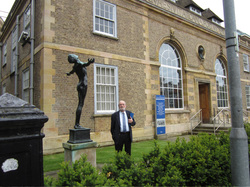
Pat outside the Scott Polar Institute.
Pat Quilty recently presented at the Scott Polar Institute in |Cambrige, England. The lecture included an appreciation of the contributions of Scott and his expedition members to the culture of Antarctica through experiences and literature. It also highlighted Scott's connection with Tasmania.
Although Robert Falcon Scott, set foot only briefly on Tasmanian soil in 1901 when he called at Macquarie Island, he had other links toTasmania.
When, early in 1913, the death of Scott and four of his companions on their return from the South Pole was announced, his sister was travelling to Tasmania the wife of the newly-appointed Governor Sir William Ellison-Macartney. His mother, another sister and a niece were also there providing a family association with Tasmania of at least four years.
When the foundation stone was laid for St Alban’s (now Edge) Anglican Church in Claremont, a parishioner offered to have installed a stained glass window to commemorate Scott.
Pat has also submitted a story of the Guinness at the South Pole Inn to John Gillies for publication a future Aurora journal.
posted 4/9/2012
Although Robert Falcon Scott, set foot only briefly on Tasmanian soil in 1901 when he called at Macquarie Island, he had other links toTasmania.
When, early in 1913, the death of Scott and four of his companions on their return from the South Pole was announced, his sister was travelling to Tasmania the wife of the newly-appointed Governor Sir William Ellison-Macartney. His mother, another sister and a niece were also there providing a family association with Tasmania of at least four years.
When the foundation stone was laid for St Alban’s (now Edge) Anglican Church in Claremont, a parishioner offered to have installed a stained glass window to commemorate Scott.
Pat has also submitted a story of the Guinness at the South Pole Inn to John Gillies for publication a future Aurora journal.
posted 4/9/2012
Sea Ice Physics and Ecosystem eXperiment (SIPEX 2)
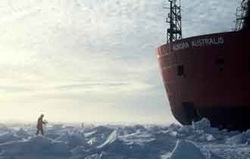
Photo by Mike Craven
Info from Antarctic Science and Ecosystems Antarctic Climate Research website
The Antarctic spring of 2012 will see the culmination of years of preparation for the ACE CRC sea-ice group, who will lead an international multi-disciplinary sea ice voyage to East Antarctica.
More than 50 scientists from eight countries are scheduled to leave on September 14 aboard the Australian research and supply vessel Aurora Australis. They will conduct the Sea Ice Physics and Ecosystem eXperiment (SIPEX-2), a seven-week voyage into the sea-ice zone to be jointly coordinated by ACE CRC and the Australian Antarctic Division.
Research will be conducted at about 100-120° East, the region off Law Dome and to the east of Australia’s Casey Station. Work will begin at the sea-ice edge and the aim will be to penetrate the pack ice towards the coastal land-fast sea ice.
The purpose of SIPEX-2 is to investigate relationships between the physical sea-ice environment, marine biogeochemistry and the structure of Southern Ocean ecosystems. While the scientists and crew will not set foot on terra firma, about 10 multi-day research stations will be set up on suitable sea ice floes.
Scientists will use an instrumented helicopter (including high-resolution aerial photography, scanning LiDAR and microwave radiometer) to determine snow and ice thickness over regional scales. They will also measure sea-ice motion and deformation to understand the effect of ocean currents and wind on sea ice.
ACE CRC bio-geochemists and ecologists are working towards a better understanding of the highly complex relationships between sea ice and snow cover physical properties, nutrients and the productivity of the sea-ice zone. Microscopic algae associated with sea ice are an important food source for Antarctic krill, a key species in Southern Ocean food web and important food source for penguins, seals and whales.
The Antarctic sea-ice zone is an important driver and indicator of global climate processes - its annual freezing and melting is considered to be one of the largest seasonal cycles on Earth. Between September and November sea ice cover will be at its maximum annual extent.
ACE CRC/AAD sea-ice ecologist Dr Klaus Meiners is the chief scientist of the project. “We aim to achieve from this voyage an expansion of the multi-disciplinary observational record of East Antarctic sea ice characteristics and processes and an assessment of impacts of climate change on the physical and biological elements of the Antarctic sea ice zone,” he said. “We will measure a large number of environmental and ecological parameters across different sea ice regimes to understand the physical processes and their impact on the ecosystem of the Southern Ocean. Data collected during the voyage will be used to improve satellite estimates of sea-ice thickness, provide input to sea-ice physical and ecosystem models and will help to detect climate change impacts in the Southern Ocean.”
One of the key players on the trip is not a scientist but an Autonomous Underwater Vehicle, which will be operated in partnership with the Woods Hole Oceanographic Institution in the United States.
The AUV, fitted with an upward-looking sonar, will measure the draft of sea ice floes. These measurements will be complemented by airborne sea-ice surface elevation and in-situ ice coring surveys to improve estimates of ice thickness and total sea-ice volume.
A Remotely Operated Vehicle (ROV) will be driven very close to the subsurface of the ice to measure optical properties to estimate the amount of ice algae as well as filming the under-ice krill population. This will help scientists to understand the relationships between sea ice, ice algae and krill. More sub-ice samples will be collected by suction pumps and nets and will be used for physiological experiments with krill.
This project is a continuation and extension of SIPEX 1, which took place in September/October 2007 and resulted in the publication of a Special Volume on Antarctic sea ice, containing 25 original publications, in the journal Deep-Sea Research II.
Follow science reporter Dr Wendy Pyper on board Aurora Australis for SIPEX-II.
Information on SIPEX 1 can be accessed from the SIPEX website
posted 4/9/2012
The Antarctic spring of 2012 will see the culmination of years of preparation for the ACE CRC sea-ice group, who will lead an international multi-disciplinary sea ice voyage to East Antarctica.
More than 50 scientists from eight countries are scheduled to leave on September 14 aboard the Australian research and supply vessel Aurora Australis. They will conduct the Sea Ice Physics and Ecosystem eXperiment (SIPEX-2), a seven-week voyage into the sea-ice zone to be jointly coordinated by ACE CRC and the Australian Antarctic Division.
Research will be conducted at about 100-120° East, the region off Law Dome and to the east of Australia’s Casey Station. Work will begin at the sea-ice edge and the aim will be to penetrate the pack ice towards the coastal land-fast sea ice.
The purpose of SIPEX-2 is to investigate relationships between the physical sea-ice environment, marine biogeochemistry and the structure of Southern Ocean ecosystems. While the scientists and crew will not set foot on terra firma, about 10 multi-day research stations will be set up on suitable sea ice floes.
Scientists will use an instrumented helicopter (including high-resolution aerial photography, scanning LiDAR and microwave radiometer) to determine snow and ice thickness over regional scales. They will also measure sea-ice motion and deformation to understand the effect of ocean currents and wind on sea ice.
ACE CRC bio-geochemists and ecologists are working towards a better understanding of the highly complex relationships between sea ice and snow cover physical properties, nutrients and the productivity of the sea-ice zone. Microscopic algae associated with sea ice are an important food source for Antarctic krill, a key species in Southern Ocean food web and important food source for penguins, seals and whales.
The Antarctic sea-ice zone is an important driver and indicator of global climate processes - its annual freezing and melting is considered to be one of the largest seasonal cycles on Earth. Between September and November sea ice cover will be at its maximum annual extent.
ACE CRC/AAD sea-ice ecologist Dr Klaus Meiners is the chief scientist of the project. “We aim to achieve from this voyage an expansion of the multi-disciplinary observational record of East Antarctic sea ice characteristics and processes and an assessment of impacts of climate change on the physical and biological elements of the Antarctic sea ice zone,” he said. “We will measure a large number of environmental and ecological parameters across different sea ice regimes to understand the physical processes and their impact on the ecosystem of the Southern Ocean. Data collected during the voyage will be used to improve satellite estimates of sea-ice thickness, provide input to sea-ice physical and ecosystem models and will help to detect climate change impacts in the Southern Ocean.”
One of the key players on the trip is not a scientist but an Autonomous Underwater Vehicle, which will be operated in partnership with the Woods Hole Oceanographic Institution in the United States.
The AUV, fitted with an upward-looking sonar, will measure the draft of sea ice floes. These measurements will be complemented by airborne sea-ice surface elevation and in-situ ice coring surveys to improve estimates of ice thickness and total sea-ice volume.
A Remotely Operated Vehicle (ROV) will be driven very close to the subsurface of the ice to measure optical properties to estimate the amount of ice algae as well as filming the under-ice krill population. This will help scientists to understand the relationships between sea ice, ice algae and krill. More sub-ice samples will be collected by suction pumps and nets and will be used for physiological experiments with krill.
This project is a continuation and extension of SIPEX 1, which took place in September/October 2007 and resulted in the publication of a Special Volume on Antarctic sea ice, containing 25 original publications, in the journal Deep-Sea Research II.
Follow science reporter Dr Wendy Pyper on board Aurora Australis for SIPEX-II.
Information on SIPEX 1 can be accessed from the SIPEX website
posted 4/9/2012
Antarctica: a biography. New book by David Day

A groundbreaking history of human interaction with Antarctica, the last continent on earth.
For centuries it was suspected that there must be an undiscovered continent in the southern hemisphere. But explorers failed to find one. On his second voyage to the Pacific, Captain James Cook sailed further south than any of his rivals but failed to sight land. It was not until 1820 that the continent's frozen coast was finally discovered and parts of the continent began to be claimed by nations that were intent on having it as their own.
That rivalry intensified in the 1840s when British, American and French expeditions sailed south to chart further portions of the continent that had come to be called Antarctica.
On and off for nearly two centuries, the race to claim exclusive possession of Antarctica has gripped the imagination of the world. Science was enlisted to buttress the rival claims as nations developed new ways of asserting territorial claims over land that was too forbidding to occupy. Although the Antarctic Treaty of 1959 was meant to end the rivalry, it has continued regardless, as new nations became involved and environmentalists, scientists and resource companies began to compete for control.
Antarctica: A biography draws upon libraries and archives from around the world to provide the first, large-scale history of Antarctica. On one level, it is the story of explorers battling the elements in the most hostile place on earth as they strive for personal triumph, commercial gain and national glory. On a deeper level, it is the story of nations seeking to incorporate the Antarctic into their national narratives and to claim its frozen wastes as their own.
Useful Links A review of the book on the Readings bookshop website can be accessed here...
For centuries it was suspected that there must be an undiscovered continent in the southern hemisphere. But explorers failed to find one. On his second voyage to the Pacific, Captain James Cook sailed further south than any of his rivals but failed to sight land. It was not until 1820 that the continent's frozen coast was finally discovered and parts of the continent began to be claimed by nations that were intent on having it as their own.
That rivalry intensified in the 1840s when British, American and French expeditions sailed south to chart further portions of the continent that had come to be called Antarctica.
On and off for nearly two centuries, the race to claim exclusive possession of Antarctica has gripped the imagination of the world. Science was enlisted to buttress the rival claims as nations developed new ways of asserting territorial claims over land that was too forbidding to occupy. Although the Antarctic Treaty of 1959 was meant to end the rivalry, it has continued regardless, as new nations became involved and environmentalists, scientists and resource companies began to compete for control.
Antarctica: A biography draws upon libraries and archives from around the world to provide the first, large-scale history of Antarctica. On one level, it is the story of explorers battling the elements in the most hostile place on earth as they strive for personal triumph, commercial gain and national glory. On a deeper level, it is the story of nations seeking to incorporate the Antarctic into their national narratives and to claim its frozen wastes as their own.
Useful Links A review of the book on the Readings bookshop website can be accessed here...
Ice Works: Three Portraits of Antarctica by David Day

A group portrait from the Imperial Trans-Antarctic Expedition, 1914-1917. Mitchell Librayr, State Library NSW [Slides 22/138]
David Day has published a brief review of 3 recent publications on Antarctica in 'the Monthly'.
The books reviewed are|:Alasdair McGregor's Antarctica: That Sweep of Savage Splendour,
Gabrielle Walker’s Antarctica: An Intimate Portrait of the World’s Most Mysterious Continent and
Australia and the Antarctic Treaty System: 50 Years of Influence by Marcus Haward and Tom Griffiths (the 2011 presenter of the Philip Law lecture).
The article can be accessed here...
posted 4/9/2012
The books reviewed are|:Alasdair McGregor's Antarctica: That Sweep of Savage Splendour,
Gabrielle Walker’s Antarctica: An Intimate Portrait of the World’s Most Mysterious Continent and
Australia and the Antarctic Treaty System: 50 Years of Influence by Marcus Haward and Tom Griffiths (the 2011 presenter of the Philip Law lecture).
The article can be accessed here...
posted 4/9/2012
One small island wins another award

from AAD website.
From Australian Antarctic Division website
A children’s book on Macquarie Island by Australian Antarctic Arts Fellows, Coral Tulloch and Alison Lester, has won a national literary award.
The Children’s Book Council of Australia has awarded One Small Island the Eve Pownall Award for Information Books.
The book details the unique story of the World Heritage listed Macquarie Island, exploring its geological beginnings, discovery and the current pest eradication program.
Coral Tulloch travelled south as an Arts Fellow in the 1998-99 season and Alison Lester in 2004-05. The authors teamed up four years ago to write and illustrate One Small Island, which was published last year.
This is the second literary award for the book after it won the Wilderness Society’s EnvironmentAward for Children’s Literature earlier this year.
The Children's Book of the Year Award: Eve Pownall Award for Information Books was first presented in 1988, when the award was financed by Eve Pownall's family. Since 1993 it has been awarded annually by the Children's Book Council of Australia (CBCA).
The Award is given to 'outstanding books which have the prime intention of documenting factual material with consideration given to imaginative presentation, interpretation and variation of style...'
posted 20/08/2012
From Australian Antarctic Division website
A children’s book on Macquarie Island by Australian Antarctic Arts Fellows, Coral Tulloch and Alison Lester, has won a national literary award.
The Children’s Book Council of Australia has awarded One Small Island the Eve Pownall Award for Information Books.
The book details the unique story of the World Heritage listed Macquarie Island, exploring its geological beginnings, discovery and the current pest eradication program.
Coral Tulloch travelled south as an Arts Fellow in the 1998-99 season and Alison Lester in 2004-05. The authors teamed up four years ago to write and illustrate One Small Island, which was published last year.
This is the second literary award for the book after it won the Wilderness Society’s EnvironmentAward for Children’s Literature earlier this year.
The Children's Book of the Year Award: Eve Pownall Award for Information Books was first presented in 1988, when the award was financed by Eve Pownall's family. Since 1993 it has been awarded annually by the Children's Book Council of Australia (CBCA).
The Award is given to 'outstanding books which have the prime intention of documenting factual material with consideration given to imaginative presentation, interpretation and variation of style...'
posted 20/08/2012
Sir Raymond Priestley and his Antarctic adventures...free lecture

Tony Fleming. (Photo: Richard Bennett)
The Royal Society of Tasmania is hosting a lecture on Sir Raymond Priestley and his Antarctic adventures by Tony Fleming (Director, Australian Antarctic Division). Tony will speak about his Grandfather Sir Raymond Priestley and his Antarctic adventures, focussing on Scott's Northern Party 1911-13.
Members of the general public are more than welcome to attend (we checked with the Secretary)...the trade off is that the RST hopes that they will consider joining the RST in the future.
When: Tuesday, 3rd July 2012 Commencing 8.00 pm until 9.30 pm
Where:17 Alma St Bellerive. (Directions: Head to Bellerive Village. After negotiating the roundabout at the junction of Rosny Hill Road and Cambridge Road, Alma Street is the second on your left. Alma St is between a Roman Catholic Church and a squash court, the meeting venue is about 250 metres up the hill on the Right Hand Side. There is plenty of parking in the grounds, and a ramp for wheelchair access, as well as steps.)
Cost: free
About the Speaker
Tony Fleming has recently been appointed the Director of the Australian Government’s Antarctic Division, with responsibility for Australia’s Antarctic program. Previously, Tony was the National Operations Manager for the Australian Wildlife Conservancy (AWC). AWC is a non-Government organisation that acquires land, and works with other landholders, to establish sanctuaries for the conservation of threatened wildlife and ecosystems. AWC currently has 22 sanctuaries covering more than 2.5 million hectares throughout Australia. Prior to joining AWC, Tony had spent 9 years with the NSW National Parks and Wildlife Service. For the first five years he was Director of the Southern Branch, then spent the last four years as Head of the Service. In that role Tony was also a member of the NSW Marine Parks Authority and Chair of the Lord Howe Island Board. Tony has previously worked in the Federal Environment Department, where he led the development of the Environment Protection and Biodiversity Conservation Act. He has also worked as a senior policy adviser to three Federal Environment ministers; Senator Graham Richardson, Ros Kelly and Senator John Faulkner.
Members of the general public are more than welcome to attend (we checked with the Secretary)...the trade off is that the RST hopes that they will consider joining the RST in the future.
When: Tuesday, 3rd July 2012 Commencing 8.00 pm until 9.30 pm
Where:17 Alma St Bellerive. (Directions: Head to Bellerive Village. After negotiating the roundabout at the junction of Rosny Hill Road and Cambridge Road, Alma Street is the second on your left. Alma St is between a Roman Catholic Church and a squash court, the meeting venue is about 250 metres up the hill on the Right Hand Side. There is plenty of parking in the grounds, and a ramp for wheelchair access, as well as steps.)
Cost: free
About the Speaker
Tony Fleming has recently been appointed the Director of the Australian Government’s Antarctic Division, with responsibility for Australia’s Antarctic program. Previously, Tony was the National Operations Manager for the Australian Wildlife Conservancy (AWC). AWC is a non-Government organisation that acquires land, and works with other landholders, to establish sanctuaries for the conservation of threatened wildlife and ecosystems. AWC currently has 22 sanctuaries covering more than 2.5 million hectares throughout Australia. Prior to joining AWC, Tony had spent 9 years with the NSW National Parks and Wildlife Service. For the first five years he was Director of the Southern Branch, then spent the last four years as Head of the Service. In that role Tony was also a member of the NSW Marine Parks Authority and Chair of the Lord Howe Island Board. Tony has previously worked in the Federal Environment Department, where he led the development of the Environment Protection and Biodiversity Conservation Act. He has also worked as a senior policy adviser to three Federal Environment ministers; Senator Graham Richardson, Ros Kelly and Senator John Faulkner.
Midwinter photos from Tas and down south online...

Photos of the Tasmanian Midwinter festivities are now on line.
If you would like better quality copies of these photos for personal use, or better still if you have photos you would like to add please email them to:
If you would like better quality copies of these photos for personal use, or better still if you have photos you would like to add please email them to:
And selection of photos from 'down south'...
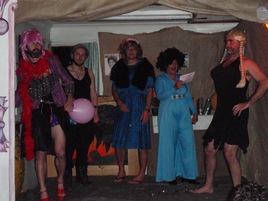
Mawson, Davis and Macca have also supplied some photos from their Midwinter festivities...
Wish we had been there, but timing and transport was too tricky...
Wish we had been there, but timing and transport was too tricky...
Midwinter Dinner Report
This years Tasmanian ANARE club midwinter dinner was a roaring success.
The dinner was held in the Hobart Function and Conference Centre over looking the space that had been occupied by the auxiliary barquentine Aurora in December 1911 prior to her departure for Antarctica with the AAE aboard.
Some 170 members and guests enjoyed a three course cordon-bleu dinner followed by coffee and assorted Tasmanian cheeses. Gifts of Tasmanian fruit pastes and postcards featuring images by Chris Wilson and Martin Passingham were organised for each guest.
Five reunions were held at the dinner: Mawson 1957, Mawson 1962, Mawson 1981, Davis 1992, and Mawson 2002. Many of those renewing old friends were from interstate and occupied 7 tables.
The highlight of the evening was the talk given by the AAD director Tony Fleming. Apart from the interesting doings of the AAD, we learnt about his family connection with Antarctica. His grandfather, Raymond Priestly, had been one of the six who lived in an ice cave for 7 months on Scott’s Terra Nova expedition.
Many thanks go to our Social Secretary Michael (Squeeze) Ooyendyk and Ingrid Mcgaughey for making this, yet another top Tasmanian ANARE Club midwinter dinner, a success.
Noel Barrett - President Tas Branch ANARE Club
This years Tasmanian ANARE club midwinter dinner was a roaring success.
The dinner was held in the Hobart Function and Conference Centre over looking the space that had been occupied by the auxiliary barquentine Aurora in December 1911 prior to her departure for Antarctica with the AAE aboard.
Some 170 members and guests enjoyed a three course cordon-bleu dinner followed by coffee and assorted Tasmanian cheeses. Gifts of Tasmanian fruit pastes and postcards featuring images by Chris Wilson and Martin Passingham were organised for each guest.
Five reunions were held at the dinner: Mawson 1957, Mawson 1962, Mawson 1981, Davis 1992, and Mawson 2002. Many of those renewing old friends were from interstate and occupied 7 tables.
The highlight of the evening was the talk given by the AAD director Tony Fleming. Apart from the interesting doings of the AAD, we learnt about his family connection with Antarctica. His grandfather, Raymond Priestly, had been one of the six who lived in an ice cave for 7 months on Scott’s Terra Nova expedition.
Many thanks go to our Social Secretary Michael (Squeeze) Ooyendyk and Ingrid Mcgaughey for making this, yet another top Tasmanian ANARE Club midwinter dinner, a success.
Noel Barrett - President Tas Branch ANARE Club
Help us organise next years dinner...
Michael and Ingrid have organized 4 out of the last 5 Tas MWDs. They are keen to have a break next year and would really appreciate it if several others would volunteer to assist with the planning and preparation. None of it is rocket science…
If interested please email
Michael and Ingrid have organized 4 out of the last 5 Tas MWDs. They are keen to have a break next year and would really appreciate it if several others would volunteer to assist with the planning and preparation. None of it is rocket science…
If interested please email
Tas Midwinter Festivities report

Many thanks to Masters of the Aurora Australis Murray Doyle and Scott Laughlin for hosting the tours of the icebreaker Aurora Australis. The initial tour was booked out within 24 hours of being advertised via the Tas. branch email and website. Scott offered to come in especially to run a second tour enabling pretty much everyone on the waitlist to be accommodated.
The tours were very comprehensive, lasting around 1.5 hours with plenty of time to look around and reminisce about our time on the Aurora Australis and the ‘little red ships’. Highlights included sitting in the captains chair (one can only dream) and several ladies in particular enjoyed having their photos taken with Murray, who we have to say was very happy to oblige…
The AAD ‘behind the scenes’ tour was similarly successful. Rosie Layton organised an interesting program including visits to the clothing store, krill lab, instrument workshop and electron microscopy lab. Sincere thanks to the hosts of each of these sections, Justin Hallock, Rob King, Steven Whiteside and Rick van den Enden who gave up their time to show us around in small groups. Each gave a great snapshot of their work, and fielded plenty of questions.
One of the funniest moments was when members of the Mawson 62 group were describing to clothing store re routine issue of string singlets and Korean army gear for use in the Antarctic in the early ANARE years. Given a choice we’d go for the stylish Mont down jacket and icebreaker thermals. anytime.
We also really appreciated the opportunity to view the Vostok 62 traverse tractor and Alices Restaurant, especially as Neville ‘Gringo’ Collins, one of the Vostok traverse team was on the tour.
Thanks to Kristin Raw, Margaret Chatwin and Stephenie Callahan who joined Rosie as group guides.
A few AAD staff including Joe Brennan, Jan Adolf and Barbara Frankel caught up with us while we were in the café for morning tea, further emphasising links between current and past expeditioners.
Other festivities included the Longest Night film festival (very well attended with packed theatres) at the State Cinema and exhibitions by Antarctic artists Stephen Eastaugh and Karin Beaumont.
The tours were very comprehensive, lasting around 1.5 hours with plenty of time to look around and reminisce about our time on the Aurora Australis and the ‘little red ships’. Highlights included sitting in the captains chair (one can only dream) and several ladies in particular enjoyed having their photos taken with Murray, who we have to say was very happy to oblige…
The AAD ‘behind the scenes’ tour was similarly successful. Rosie Layton organised an interesting program including visits to the clothing store, krill lab, instrument workshop and electron microscopy lab. Sincere thanks to the hosts of each of these sections, Justin Hallock, Rob King, Steven Whiteside and Rick van den Enden who gave up their time to show us around in small groups. Each gave a great snapshot of their work, and fielded plenty of questions.
One of the funniest moments was when members of the Mawson 62 group were describing to clothing store re routine issue of string singlets and Korean army gear for use in the Antarctic in the early ANARE years. Given a choice we’d go for the stylish Mont down jacket and icebreaker thermals. anytime.
We also really appreciated the opportunity to view the Vostok 62 traverse tractor and Alices Restaurant, especially as Neville ‘Gringo’ Collins, one of the Vostok traverse team was on the tour.
Thanks to Kristin Raw, Margaret Chatwin and Stephenie Callahan who joined Rosie as group guides.
A few AAD staff including Joe Brennan, Jan Adolf and Barbara Frankel caught up with us while we were in the café for morning tea, further emphasising links between current and past expeditioners.
Other festivities included the Longest Night film festival (very well attended with packed theatres) at the State Cinema and exhibitions by Antarctic artists Stephen Eastaugh and Karin Beaumont.
Chris Wilson wins in photo competition

Photo by Chris Wilson
EWEA (European Wind Energy association) and GWEC (Global Wind Energy Council) recently announced the winners of the Global Wind Day photo competition ‘Wind in Mind’.
The winners were selected by a professional jury from over 2300 submitted entries from over 40 countries. The overall Global Winner was Markus Haslinger. Chris Wilson was the winner of the Australia, Oceania, Antarctica section.
The EWEA website reports...
'...the wining photo captured a wind turbine set against a backdrop of the Southern Lights in Antarctica. The frame, captured by Chris Wilson, was taken at Mawson station. “At the time I was living and working at the station for 14 months, and had many opportunities to witness and photograph the beautiful Aurora Australis. We have two 300kW wind turbines at Mawson which are capable of carrying 100% of the station load for long periods of time,” Wilson said. The turbines have been specially adapted to the tough climate conditions of the Antarctic.
“Before the introduction of renewable energy systems, Australian stations required 2.1 mega litres of diesel fuel annually to provide power and heating. Burning this fuel produced around 5,500 tonnes of CO2 into the pristine Antarctic environment,” Wilson said, but now “Mawson station is able to produce environmentally friendly power via the wind turbines to supply both electricity and heat,” he added...'
Congratulations Chris!
The winners were selected by a professional jury from over 2300 submitted entries from over 40 countries. The overall Global Winner was Markus Haslinger. Chris Wilson was the winner of the Australia, Oceania, Antarctica section.
The EWEA website reports...
'...the wining photo captured a wind turbine set against a backdrop of the Southern Lights in Antarctica. The frame, captured by Chris Wilson, was taken at Mawson station. “At the time I was living and working at the station for 14 months, and had many opportunities to witness and photograph the beautiful Aurora Australis. We have two 300kW wind turbines at Mawson which are capable of carrying 100% of the station load for long periods of time,” Wilson said. The turbines have been specially adapted to the tough climate conditions of the Antarctic.
“Before the introduction of renewable energy systems, Australian stations required 2.1 mega litres of diesel fuel annually to provide power and heating. Burning this fuel produced around 5,500 tonnes of CO2 into the pristine Antarctic environment,” Wilson said, but now “Mawson station is able to produce environmentally friendly power via the wind turbines to supply both electricity and heat,” he added...'
Congratulations Chris!
Antarctic Medal Recipients
from AAD website
21st June 2012
Environment Minister Tony Burke has congratulated the recipients of the 2012 Antarctic Medal which is awarded for outstanding service to the Australian Antarctic program.
The Governor General, Her Excellency, Quentin Bryce AC CVO today announced the Antarctic medals were awarded to oceanographer Dr Steve Rintoul and medical practitioner Dr James Doube.
A posthumous award was given to meteorologist Dr Neil Adams and a clasp to the Antarctic Medal was awarded to Dr Graham Robertson. Read more...
from AAD website
21st June 2012
Environment Minister Tony Burke has congratulated the recipients of the 2012 Antarctic Medal which is awarded for outstanding service to the Australian Antarctic program.
The Governor General, Her Excellency, Quentin Bryce AC CVO today announced the Antarctic medals were awarded to oceanographer Dr Steve Rintoul and medical practitioner Dr James Doube.
A posthumous award was given to meteorologist Dr Neil Adams and a clasp to the Antarctic Medal was awarded to Dr Graham Robertson. Read more...
Tas MWD ...table seating available on line

We have 168 people coming to the Tas MWD ...it's going to be a great night!!
A list of attendees can be accessed here...
Name tags will be available at the door. The MWD seating arrangements can be accessed here...
There will also be a list just inside the door. The locations of tables can be accessed here...
Please note the venue opens from 6pm for pre dinner drinks. Dinner will be served pretty shortly after 7pm. Further details can be accessed here...
For those that are unfamiliar with the location, the Hobart Function and Conference Centre is on the Elizabeth street wharf on the waterfront. Walk down the right hand side of the buildings , and the entrance is half way along. We will have people looking out for you from 6pm. Those with mobility issues can be dropped by car or taxi at the entrance to the venue.
Any final enquires should be directed to Michael Ooyendyk on 0408 007 640 or email:
A list of attendees can be accessed here...
Name tags will be available at the door. The MWD seating arrangements can be accessed here...
There will also be a list just inside the door. The locations of tables can be accessed here...
Please note the venue opens from 6pm for pre dinner drinks. Dinner will be served pretty shortly after 7pm. Further details can be accessed here...
For those that are unfamiliar with the location, the Hobart Function and Conference Centre is on the Elizabeth street wharf on the waterfront. Walk down the right hand side of the buildings , and the entrance is half way along. We will have people looking out for you from 6pm. Those with mobility issues can be dropped by car or taxi at the entrance to the venue.
Any final enquires should be directed to Michael Ooyendyk on 0408 007 640 or email:
AAD tour arrangements...final details
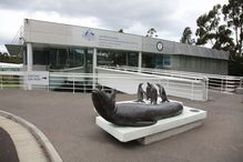
The AAD tour is being run on Monday 25th June 2012.
Please meet at the main entrance of the AAD, Channel Hwy, Kingston at 08.45 am. The tour will start promptly at 9am.
Covered /enclosed shoes will need to be worn as a number of workshop areas are being accessed.
A short break is scheduled mid tour and morning tea may be purchased at the AAD cafe at your own expense.
Please note that his tour is full and additional people cannot be added.
A list of people on the tour can be accessed here...
If transport to and from the Australian Antarctic Division at Kingston (about 15 kilometres south of Hobart) is required, please contact us so we can advise of transport arrangements.
posted 18/6/2012.
Please meet at the main entrance of the AAD, Channel Hwy, Kingston at 08.45 am. The tour will start promptly at 9am.
Covered /enclosed shoes will need to be worn as a number of workshop areas are being accessed.
A short break is scheduled mid tour and morning tea may be purchased at the AAD cafe at your own expense.
Please note that his tour is full and additional people cannot be added.
A list of people on the tour can be accessed here...
If transport to and from the Australian Antarctic Division at Kingston (about 15 kilometres south of Hobart) is required, please contact us so we can advise of transport arrangements.
posted 18/6/2012.
Aurora Australis tour...final details

Photo by Martin Passingham.
2 Tours of the Aurora Australis are been run on Saturday 23rd June 2012.
Please meet outside the front doors (city side) of Princess Wharf 1...just next to Salamanca, by 13.15.
Covered /enclosed shoes will need to be worn
Please note that his tour is full and additional people cannot be added.
A list of people on the tour can be accessed here...
Please meet outside the front doors (city side) of Princess Wharf 1...just next to Salamanca, by 13.15.
Covered /enclosed shoes will need to be worn
Please note that his tour is full and additional people cannot be added.
A list of people on the tour can be accessed here...
Invite from Macca for Midwinter celebrations
(addressed to Squeeze /Ingrid, but we are told that all ANARE are invited....)
(addressed to Squeeze /Ingrid, but we are told that all ANARE are invited....)
Your browser does not support viewing this document. Click here to download the document.
The Davis Midwinter invitation
An invite to the Mawson Midwinter activities
National ANARE AGM
The Annual General Meeting (AGM) of the ANARE Club Incorporated will be held at Bayview Eden, 6 Queens Road, Melbourne on 16 July 2012 at 7 pm.
The AGM provides an opportunity for the progress of the Club to be reviewed and its future course planned. All members are invited to attend and refreshments will be provided. The AGM is always an enjoyable occasion.
The Annual Reports of the President and the Treasurer will be tabled for discussion and adoption, and elections for the members of the National Council will be held. Under the current Constitution of the ANARE Club, 13 positions are available for election to the National Council; the five Office Bearers (President, Vice President, Treasurer, Secretary and Social Secretary) and eight Ordinary Members who may be later appointed to other positions including Aurora Editor, Membership Officer, Webmaster, Sales Officer and Historian.
Meetings of the Council are currently held quarterly in Melbourne but interstate members are encouraged to nominate and assistance with travel expenses is provided.
Members who are unable to attend are invited to appoint a proxy, according to the guidelines given below...
ANARE Club Proxy Voting Guidelines
If an ANARE Club member is unable to attend the AGM on 16 July 2012 and vote on an issue personally, that member can appoint another ANARE Club member to cast a vote on their behalf (that is ‘vote by proxy’) at the AGM.
Each full, financial member has the right to appoint a proxy.
Only a full and financial member can act as a proxy.
The Secretary of the ANARE Club must receive the proxy forms at least 24 hours before the commencement of the AGM.
Proxy forms may be delivered by mail, email or hand delivered. Verbal proxies are not acceptable. For postal submissions it should be addressed as follows: The Secretary, PO Box 2534, Melbourne, 3001. Victoria.
Hard copy submissions of the proxy form must be signed by the member who is appointing another person to vote on their behalf.
Email copy submissions of the proxy form do not need to be signed by the member who is appointing another person to vote on their behalf, but must be sent from a verifiable email address. Read more here...
The Annual General Meeting (AGM) of the ANARE Club Incorporated will be held at Bayview Eden, 6 Queens Road, Melbourne on 16 July 2012 at 7 pm.
The AGM provides an opportunity for the progress of the Club to be reviewed and its future course planned. All members are invited to attend and refreshments will be provided. The AGM is always an enjoyable occasion.
The Annual Reports of the President and the Treasurer will be tabled for discussion and adoption, and elections for the members of the National Council will be held. Under the current Constitution of the ANARE Club, 13 positions are available for election to the National Council; the five Office Bearers (President, Vice President, Treasurer, Secretary and Social Secretary) and eight Ordinary Members who may be later appointed to other positions including Aurora Editor, Membership Officer, Webmaster, Sales Officer and Historian.
Meetings of the Council are currently held quarterly in Melbourne but interstate members are encouraged to nominate and assistance with travel expenses is provided.
Members who are unable to attend are invited to appoint a proxy, according to the guidelines given below...
ANARE Club Proxy Voting Guidelines
If an ANARE Club member is unable to attend the AGM on 16 July 2012 and vote on an issue personally, that member can appoint another ANARE Club member to cast a vote on their behalf (that is ‘vote by proxy’) at the AGM.
Each full, financial member has the right to appoint a proxy.
Only a full and financial member can act as a proxy.
The Secretary of the ANARE Club must receive the proxy forms at least 24 hours before the commencement of the AGM.
Proxy forms may be delivered by mail, email or hand delivered. Verbal proxies are not acceptable. For postal submissions it should be addressed as follows: The Secretary, PO Box 2534, Melbourne, 3001. Victoria.
Hard copy submissions of the proxy form must be signed by the member who is appointing another person to vote on their behalf.
Email copy submissions of the proxy form do not need to be signed by the member who is appointing another person to vote on their behalf, but must be sent from a verifiable email address. Read more here...
ANARE Memorial Service
When: Thursday, 21st June 2012 10:00 AM-11:00 AM (GMT+10:00) Hobart.
Where: AAD Memorial Rock Kingston Tas 21st June.
Vale Eric King D77, Q81
Eric King, from the Instrument Workshop at the AAD, sadly passed away on June 13th 2012. The funeral service will be held at the Woodbridge Uniting Church, on Friday morning 15th June at 11am. No flowers by request. in lieu donations to Tasmanian Land Conservancy appreciated.
Eric King, from the Instrument Workshop at the AAD, sadly passed away on June 13th 2012. The funeral service will be held at the Woodbridge Uniting Church, on Friday morning 15th June at 11am. No flowers by request. in lieu donations to Tasmanian Land Conservancy appreciated.
Antarctica divided into distinct biogeographic regions
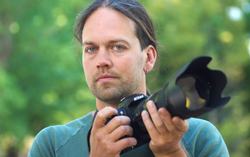
From AAD website
New research into the biogeography of Antarctica has identified 15 distinct regions on the continent and near-shore islands.
The study, published in Diversity and Distribution Journal today, examined the geography, geology, climate, flora and fauna of the ice-free areas of Antarctica and indentified the biologically distinct Antarctic Conservation Biogeographic Regions.
The lead author and Australian Antarctic Division terrestrial biologist Dr Aleks Terauds, said this is the first time there has been a continent-wide assessment of the biogeography of Antarctica using all of the available biodiversity data.
Dr Terauds is presenting the new research at the prestigious Scientific Committee on Antarctic Research lecture at the Antarctic Treaty Consultative Meeting (ATCM) in Hobart today. Read more...
posted 13/6/2012
New research into the biogeography of Antarctica has identified 15 distinct regions on the continent and near-shore islands.
The study, published in Diversity and Distribution Journal today, examined the geography, geology, climate, flora and fauna of the ice-free areas of Antarctica and indentified the biologically distinct Antarctic Conservation Biogeographic Regions.
The lead author and Australian Antarctic Division terrestrial biologist Dr Aleks Terauds, said this is the first time there has been a continent-wide assessment of the biogeography of Antarctica using all of the available biodiversity data.
Dr Terauds is presenting the new research at the prestigious Scientific Committee on Antarctic Research lecture at the Antarctic Treaty Consultative Meeting (ATCM) in Hobart today. Read more...
posted 13/6/2012
Request for funding for Antarctic feature film
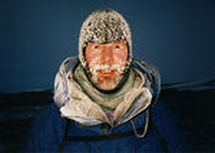
ANARE Club member Jenna Kelly writes:
'...My ice companion (Anthony Powell) from Scott Base is making a movie. He needs lots of support and I was hoping you might be able to send this out to ANARE members to see if anyone would be willing to help him out?...'
There is a website re the project -worth looking at for the video presentation featuring antarctic scenery alone. Other examples of his work can be seen here...
ABOUT THIS PROJECT: Anthony Powell has been working in Antarctica since 1998, and steadily gathering footage for this project for the last 10 years. His work has appeared in numerous locations all over the world, including the Natural History Museum in New York, National Geographic Channel, Discovery, and most recently BBC's Frozen Planet series.
Anthony is in the final stages of organising a feature film about what it is like to live at the bottom of the planet, in Antarctica, for a full year. The story is not from the point of view of scientists, but of the everyday workers who are there to keep the stations running in the coldest place on the planet...
...Documentary film crews usually only get to visit Antarctica during the few short months of summer. This film includes footage meticulously gathered over 10 years, including 9 winters, isolated from the rest of the world, in 24-hour darkness and mind-numbing cold for months at a time...'
The filming is finally completed, the first edits done. Now Anthony is looking for additional assistance with funding. Read more...
posted 13/6/2012
'...My ice companion (Anthony Powell) from Scott Base is making a movie. He needs lots of support and I was hoping you might be able to send this out to ANARE members to see if anyone would be willing to help him out?...'
There is a website re the project -worth looking at for the video presentation featuring antarctic scenery alone. Other examples of his work can be seen here...
ABOUT THIS PROJECT: Anthony Powell has been working in Antarctica since 1998, and steadily gathering footage for this project for the last 10 years. His work has appeared in numerous locations all over the world, including the Natural History Museum in New York, National Geographic Channel, Discovery, and most recently BBC's Frozen Planet series.
Anthony is in the final stages of organising a feature film about what it is like to live at the bottom of the planet, in Antarctica, for a full year. The story is not from the point of view of scientists, but of the everyday workers who are there to keep the stations running in the coldest place on the planet...
...Documentary film crews usually only get to visit Antarctica during the few short months of summer. This film includes footage meticulously gathered over 10 years, including 9 winters, isolated from the rest of the world, in 24-hour darkness and mind-numbing cold for months at a time...'
The filming is finally completed, the first edits done. Now Anthony is looking for additional assistance with funding. Read more...
posted 13/6/2012
250 Mile Depot, Mawson...

The Tas branch website is keen to circulate photos and stories of past and current ANARE activities. If you have a photo and /or a bit of a story, just send it in to us.
We saw this photo from Phil Barnaart recently...
'...It was taken during our "Autumn Traverse" on Friday 22 April 1988 at "250 Mile Depot" which was laid by Bill Bewsher (OIC) and his crew during the 1956 Mawson ANARE and our visit was the first since the depot was established.
It contained rations, clothing and spare parts for the "Weasel" tracked vehicles and dog sleds used at the time. Although much of the depot had been scattered by the wind and ice movement during the intervening 32 years, it was easy enough to locate using field trip reports from 1956.
On the day, we had finished our task of locating a suitable site for the proposed Dovers base at the foot of Mt Jacklyn in the Northern Prince Charles Mountains, and depoting 320 drums of fuel and other stores for operations at Dovers during the following summer. Before starting the journey back to Mawson station, we decided to try to locate Bewsher's depot as the "Weasel" spares might be handy for restoration purposes (and we really wanted to find it!)
The weather conditions at the time were: clear sky, temperature minus 25.5, wind from the SW averaging 40 knots gusting to 50. I recorded in the traverse log "perfect weather at sunset"! It got down to minus 42 on the traverse though and on 27 days the temperature was less than minus 30. The traverse lasted six weeks. We had a ball.
On the way back we re-explored a slightly shorter route to Mawson station which hadn't been used for years. We also located Bob Dover's "50 Mile Depot" but that is another story...No traverses had operated out of Mawson for eight years and without Dave McCormack's expertise it's doubtful we would have achieved what we did...'
We saw this photo from Phil Barnaart recently...
'...It was taken during our "Autumn Traverse" on Friday 22 April 1988 at "250 Mile Depot" which was laid by Bill Bewsher (OIC) and his crew during the 1956 Mawson ANARE and our visit was the first since the depot was established.
It contained rations, clothing and spare parts for the "Weasel" tracked vehicles and dog sleds used at the time. Although much of the depot had been scattered by the wind and ice movement during the intervening 32 years, it was easy enough to locate using field trip reports from 1956.
On the day, we had finished our task of locating a suitable site for the proposed Dovers base at the foot of Mt Jacklyn in the Northern Prince Charles Mountains, and depoting 320 drums of fuel and other stores for operations at Dovers during the following summer. Before starting the journey back to Mawson station, we decided to try to locate Bewsher's depot as the "Weasel" spares might be handy for restoration purposes (and we really wanted to find it!)
The weather conditions at the time were: clear sky, temperature minus 25.5, wind from the SW averaging 40 knots gusting to 50. I recorded in the traverse log "perfect weather at sunset"! It got down to minus 42 on the traverse though and on 27 days the temperature was less than minus 30. The traverse lasted six weeks. We had a ball.
On the way back we re-explored a slightly shorter route to Mawson station which hadn't been used for years. We also located Bob Dover's "50 Mile Depot" but that is another story...No traverses had operated out of Mawson for eight years and without Dave McCormack's expertise it's doubtful we would have achieved what we did...'
Tasmania hosts Antarctic treaty meeting

From Fiona Blackwood, ABC News
adapted from ABC website
About 350 delegates from 50 countries will meet in Hobart to discuss issues surrounding the science and future protection of the icy landmass. It is only the third time since the treaty was formed in 1959 that Australia has hosted a meeting.
ANARE Club member Andrew Jackson who has played a pivotal role in the organisation of the treaty meeting as the head of the Australian secretariat says a focus for this year's meeting will be the environmental impact of the growing numbers of visitors to the continent.
"Whether they're from national science programs or from tourist visitors there is a risk of non indigenous species being introduced into the region and we need to understand how that happens and that needs to be watched carefully so we don't have uncontrolled expansion without understanding what the environmental consequences might be," he said.
Attached is a link to a video by ABC reporter Fiona Blackwood which involves an interesting interview with Andrew and other delegates. Love the ANARE flag in the background...
Duration of video: 1min 41sec
posted 11/6/2012
adapted from ABC website
About 350 delegates from 50 countries will meet in Hobart to discuss issues surrounding the science and future protection of the icy landmass. It is only the third time since the treaty was formed in 1959 that Australia has hosted a meeting.
ANARE Club member Andrew Jackson who has played a pivotal role in the organisation of the treaty meeting as the head of the Australian secretariat says a focus for this year's meeting will be the environmental impact of the growing numbers of visitors to the continent.
"Whether they're from national science programs or from tourist visitors there is a risk of non indigenous species being introduced into the region and we need to understand how that happens and that needs to be watched carefully so we don't have uncontrolled expansion without understanding what the environmental consequences might be," he said.
Attached is a link to a video by ABC reporter Fiona Blackwood which involves an interesting interview with Andrew and other delegates. Love the ANARE flag in the background...
Duration of video: 1min 41sec
posted 11/6/2012
Get ready to capture the Winter Solstice:
for those in Tasmania and Macquarie Island
By Tim Walker ABC Tas website
Ladies and gentlemen, start your cameras. For the past few years, ABC Hobart and ABC Northern Tasmania have called out for photos capturing the day or night of the Winter Solstice. 2009 was the shortest day photo call out, 2010 was the longest night call out, and 2011 was for any photo taken day or night. 2012 will be 'the moment of solstice'.
The Winter solstice falls on Thursday 21 June 2012, at 9:09AM EST this year.
ABC Hobart and ABC Northern Tasmania would like help to capture the moment around Tasmania with a photo gallery that signifies the beginning of the Sun's movement back towards the southern latitudes.
If it is possible, take a photo at the exact moment of something that represents Winter in Tasmania for you. But don't dispair if you are not free at that moment. For the 24 hours after the solstice, you can take a photo at 9 minutes past any hour of the day or night, to be included in the collection.
You can submit the photo via the ABC Contribute page in Northern Tasmania or Hobart.
Alternatively you can use the 936 Hobart Flickr group or the ABC Northern Tasmania Flickr group page to upload your photo.
Make sure you include the time and place details in the description of your photo, and please include the tag 'solstice2012'.
In 2010 we collected a photo gallery of the longest night, and in 2011 we celebrated the shortest day in photos.
This year's collection will tell the story of a day and a night following the Winter solstice.
Get your cameras ready, start planning where you can shoot, and look out for that special location that will capture the Winter solstice.
posted 11/6/2012
for those in Tasmania and Macquarie Island
By Tim Walker ABC Tas website
Ladies and gentlemen, start your cameras. For the past few years, ABC Hobart and ABC Northern Tasmania have called out for photos capturing the day or night of the Winter Solstice. 2009 was the shortest day photo call out, 2010 was the longest night call out, and 2011 was for any photo taken day or night. 2012 will be 'the moment of solstice'.
The Winter solstice falls on Thursday 21 June 2012, at 9:09AM EST this year.
ABC Hobart and ABC Northern Tasmania would like help to capture the moment around Tasmania with a photo gallery that signifies the beginning of the Sun's movement back towards the southern latitudes.
If it is possible, take a photo at the exact moment of something that represents Winter in Tasmania for you. But don't dispair if you are not free at that moment. For the 24 hours after the solstice, you can take a photo at 9 minutes past any hour of the day or night, to be included in the collection.
You can submit the photo via the ABC Contribute page in Northern Tasmania or Hobart.
Alternatively you can use the 936 Hobart Flickr group or the ABC Northern Tasmania Flickr group page to upload your photo.
Make sure you include the time and place details in the description of your photo, and please include the tag 'solstice2012'.
In 2010 we collected a photo gallery of the longest night, and in 2011 we celebrated the shortest day in photos.
This year's collection will tell the story of a day and a night following the Winter solstice.
Get your cameras ready, start planning where you can shoot, and look out for that special location that will capture the Winter solstice.
posted 11/6/2012
Down South opens in Ballarat Victoria
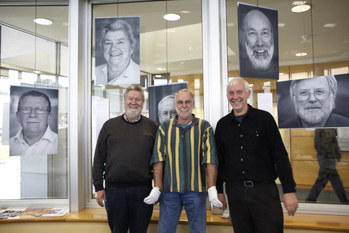
Robin Regester, Paul Hedt and Noddy Fletcher (all Casey ’76 stalwarts) had a great time and some light hearted fun putting up the Down South Exhibition at Ballarat Library last week.
This exhibition will run until August 12th 2012. The address is 178 Doveton Street North, Ballarat 3350.
The library staff have asked if any ex ANARE personnel can assist with talking to school students most likely on a Tuesday or Thursday daytime - they would be most appreciative. If anyone is interested in assisting can they contact Noddy at [email protected] or 0418 567218.
posted 11/6/2012.
This exhibition will run until August 12th 2012. The address is 178 Doveton Street North, Ballarat 3350.
The library staff have asked if any ex ANARE personnel can assist with talking to school students most likely on a Tuesday or Thursday daytime - they would be most appreciative. If anyone is interested in assisting can they contact Noddy at [email protected] or 0418 567218.
posted 11/6/2012.
AAD Director Queens Birthday honour

Photo from AAD website.
Ms Lyn Maddock, the previous Director of the Australian Antarctic Division has been awarded a Member (AM) in the General Division in the Queens Birthday Honors list. Her citation reads:
Lynnita Mary MADDOCK PSM, Richmond, Vic. For service to public administration, particularly in the area of Australia's Antarctic operations, to the development of natural resources and environmental protection strategies, and to scientific research.
Read more: http://www.smh.com.au/national/queens-birthday-honours-20120610-2049o.html#ixzz1xQl38On7
Congratulations Lyn!!
posted 11/6/2012
Lynnita Mary MADDOCK PSM, Richmond, Vic. For service to public administration, particularly in the area of Australia's Antarctic operations, to the development of natural resources and environmental protection strategies, and to scientific research.
Read more: http://www.smh.com.au/national/queens-birthday-honours-20120610-2049o.html#ixzz1xQl38On7
Congratulations Lyn!!
posted 11/6/2012
Gaining World Heritage Listing for Antarctica
from Australian Conservation Foundation Website
Correcting a great injustice – the present exclusion of Antarctica from World Heritage consideration. As things stand, Antarctica, the part of the world with arguably the most Outstanding Universal Values, cannot be added to the World Heritage List.
The forum will focus on why and how this monumental environmental injustice can be corrected. Speakers will outline the Outstanding Universal Values of Antarctica including what World Heritage Listing would contribute to international environmental conservation, how the World Heritage Convention can be amended to make listing possible and the leading role Australia can play in securing World Heritage Listing for Antarctica.
Hear about the present legal situation and how it can be corrected as well as lessons from the past. The forum is being held at the time of the 35th Antarctic Treaty Consultative Meeting in Hobart for the first time ever, and in the year which is the Fortieth Anniversary of the World Heritage Convention.
Come along and join the discussion on World Heritage Listing of Antarctica.
Read more about securing Antarctica’s conservation and protection.
When: Sunday, 17 June 2012 at 2:00pm
Where: Salamanca Arts Centre, Peacock Theatre, 77 Salamanca Place, Hobart
Cost: free
Contact: For more information contact Geoff Mosley (03) 9718 2998 or[email protected]
thanks to Owen Holmwood for the above information...
posted 4/6/2012
from Australian Conservation Foundation Website
Correcting a great injustice – the present exclusion of Antarctica from World Heritage consideration. As things stand, Antarctica, the part of the world with arguably the most Outstanding Universal Values, cannot be added to the World Heritage List.
The forum will focus on why and how this monumental environmental injustice can be corrected. Speakers will outline the Outstanding Universal Values of Antarctica including what World Heritage Listing would contribute to international environmental conservation, how the World Heritage Convention can be amended to make listing possible and the leading role Australia can play in securing World Heritage Listing for Antarctica.
Hear about the present legal situation and how it can be corrected as well as lessons from the past. The forum is being held at the time of the 35th Antarctic Treaty Consultative Meeting in Hobart for the first time ever, and in the year which is the Fortieth Anniversary of the World Heritage Convention.
Come along and join the discussion on World Heritage Listing of Antarctica.
Read more about securing Antarctica’s conservation and protection.
When: Sunday, 17 June 2012 at 2:00pm
Where: Salamanca Arts Centre, Peacock Theatre, 77 Salamanca Place, Hobart
Cost: free
Contact: For more information contact Geoff Mosley (03) 9718 2998 or[email protected]
thanks to Owen Holmwood for the above information...
posted 4/6/2012
ANARE items on display at Traversing Antarctica exhibition

1. Stubby Cooler
Stubby cooler: This leather stubby cooler is lined with polystyrene foam and was made by plant operator, Max Riley at Casey station for Christmas celebrations in 1980.
Traversing Antarctica highlights Australia's connection with the Antarctic. The exhibition includes a rare collection of artifacts that are on display together for the first time, among them are original equipment and diaries used by members of the Australasian Antarctic Expedition. The exhibition also includes several large format photographs by ANARE Club member Chris Wilson as well as several hobby items made by ANARE expeditioners which have been loaned by Phil Barnaart.
Where: National Archives of Australia, Queen Victoria Tce, Parkes, ACT
When: 23rd March -9th September 2012
Cost: free
Traversing Antarctica highlights Australia's connection with the Antarctic. The exhibition includes a rare collection of artifacts that are on display together for the first time, among them are original equipment and diaries used by members of the Australasian Antarctic Expedition. The exhibition also includes several large format photographs by ANARE Club member Chris Wilson as well as several hobby items made by ANARE expeditioners which have been loaned by Phil Barnaart.
Where: National Archives of Australia, Queen Victoria Tce, Parkes, ACT
When: 23rd March -9th September 2012
Cost: free
Antarctic musings win literary award at Sydney Writers Festival
from AAD website
Antarctic Arts Fellow, Jesse Blackadder, has won a literary award at the Sydney Writers’ Festival.
Ms Blackadder’s essay The first woman and the last dog in Antarctica won the Guy Morrison Award for Literary Journalism.
The 2012 Guy Morrison Prize judge, Nikki Barrowclough, said the essay was compelling.
“From her glorious opening paragraph, which immediately captivated me, Jesse Blackadder has produced a spirited, beautifully written and structured story, bringing to light the history of the first woman to reach Antarctica,” Nikki Barrowclough said.
Jesse Blackadder travelled to Davis station in 2010-11 as part of the Australian Antarctic Division’s Arts Fellowship program. Read more..
from AAD website
Antarctic Arts Fellow, Jesse Blackadder, has won a literary award at the Sydney Writers’ Festival.
Ms Blackadder’s essay The first woman and the last dog in Antarctica won the Guy Morrison Award for Literary Journalism.
The 2012 Guy Morrison Prize judge, Nikki Barrowclough, said the essay was compelling.
“From her glorious opening paragraph, which immediately captivated me, Jesse Blackadder has produced a spirited, beautifully written and structured story, bringing to light the history of the first woman to reach Antarctica,” Nikki Barrowclough said.
Jesse Blackadder travelled to Davis station in 2010-11 as part of the Australian Antarctic Division’s Arts Fellowship program. Read more..
Midwinter Tours of the Australian Antarctic Division
Generally access to the Australian Antarctic Division is limited to the foyer display and the cafe, however this year the Division has kindly offered to host several special tours for ANARE expeditioners and their guests for the Midwinter festivities.
This year there will be 2 tours. The first is on Friday 22nd June at 2pm and will include a video link up with Mawson Station, while the second is on Monday 25th June at 9am and will include a video link up with Casey Station. Other highlights include a welcome by Dr Tony Flemming, the new AAD director, as well as opportunities to view the Clothing store and warehouse, Instrument workshop, Krill lab and Electron microscopy department. Around 3 hours should be allowed for the visit.
There is no charge for the tour. Last years tour was extremely popular, and received a lot of great feedback, so if you are interested please contact us early as numbers are limited to 60 (30 people each tour).
If transport to and from the Australian Antarctic Division at Kingston (about 15 kilometres south of Hobart) is required, please contact us so we can advise of transport arrangements.
Where: Australian Antarctic Division, Kingston, Hobart
When: Friday 22nd june 2pm and Monday 25th June 9am.
Cost: free
DOWN SOUTH at Ballarat Library, Victoria
For over 60 years, Australian tradespeople have been drawn to the Antarctic by the prospect of great adventure and mateship. Plumbers, electricians, carpenters, diesel mechanics, cooks, radio operators and weather observers were the mainstay of the Antarctic home base. The scientists couldn't have remained in Antarctica and undertaken their research without the support and contribution of these skilled workers.
Susan Gordon-Brown, the photographer, has spoken to 25 tradespeople and photographed them as they are now. They are now between the ages of 50 and 93 years old. The exhibition is a combination of these portraits and their stories, as written by Gayl O’Connor.
When: 12th June - 7th August 2012
Where: Ballarat Libray, Ballarat, Victoria
Cost: free
Further details can be found at: http://www.downsouth.org.au
posted 28/05/2012
For over 60 years, Australian tradespeople have been drawn to the Antarctic by the prospect of great adventure and mateship. Plumbers, electricians, carpenters, diesel mechanics, cooks, radio operators and weather observers were the mainstay of the Antarctic home base. The scientists couldn't have remained in Antarctica and undertaken their research without the support and contribution of these skilled workers.
Susan Gordon-Brown, the photographer, has spoken to 25 tradespeople and photographed them as they are now. They are now between the ages of 50 and 93 years old. The exhibition is a combination of these portraits and their stories, as written by Gayl O’Connor.
When: 12th June - 7th August 2012
Where: Ballarat Libray, Ballarat, Victoria
Cost: free
Further details can be found at: http://www.downsouth.org.au
posted 28/05/2012
More on the 'Neptune' air crash: a view from the airmen
Bill Burch wrote:
'...A new article has just been written for an on-line paper published by the US Antarctic Program, telling the story from inside the plane as well as outside. It makes interesting reading. http://antarcticsun.usap.gov/features/contenthandler.cfm?id=2658...'
posted 25/5/2012
An Awfully Beautiful Place - The Antarctic Art of Stephen Eastaugh: invite to opening and film
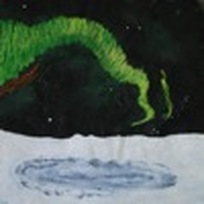
This exhibition spans ten years of Stephen Eastaugh's work dealing with Antarctica.In total the artist has spent eighteen months on the 'Ice', a time span no other contemporary Australian artist has committed to the white continent.
This exhibition is a survey show that presents massive landscape based wall hangings produced at Mawson Station during winter, cartographic pattern works from a summer at DavisStation, and tiny 'Travailogue' works created on numerous journeys across theSouthern Ocean.
Where: Carnegie Gallery, Hobart,
When: 7th June - 1st July 2012
Cost: free
Exhibition opening 6.00pm Thursday 7 June 2012. All invited!!!
Opening speaker: Dr Tony Press - CEO Antarctic Climate + Ecosystems Cooperative Research Centre and ex-director of the Aust. Antarctic Division.
You are also invited to attend a screening of the artist's documentary winteroverat 1pm tuesday 12th june in the gallery, followed by q and a.
"I keep returning to Antarctica to collect sublime views, fecund experiences and to make art.My work meanders between representational scenes and non-figuration but I regard all aslandscapes synthesized from a long romance with a rather remote part of the planet."
- Stephen Eastaugh
This exhibition is a survey show that presents massive landscape based wall hangings produced at Mawson Station during winter, cartographic pattern works from a summer at DavisStation, and tiny 'Travailogue' works created on numerous journeys across theSouthern Ocean.
Where: Carnegie Gallery, Hobart,
When: 7th June - 1st July 2012
Cost: free
Exhibition opening 6.00pm Thursday 7 June 2012. All invited!!!
Opening speaker: Dr Tony Press - CEO Antarctic Climate + Ecosystems Cooperative Research Centre and ex-director of the Aust. Antarctic Division.
You are also invited to attend a screening of the artist's documentary winteroverat 1pm tuesday 12th june in the gallery, followed by q and a.
"I keep returning to Antarctica to collect sublime views, fecund experiences and to make art.My work meanders between representational scenes and non-figuration but I regard all aslandscapes synthesized from a long romance with a rather remote part of the planet."
- Stephen Eastaugh
'Southern lights' images from Antarctica
This collection of striking images from Antarctica and the sub-Antarctic is the result of six journeys made to these southernmost lands by Australian photographer David Neilson. The areas covered include the Antarctic Peninsula, East Antarctica, the Ross Sea, South Georgia and Macquarie Island. These outstanding landscape and wildlife photographs are reproduced in both colour and black and white and reveal a part of the grandeur and mystery of this great southern realm.
Hardback, 305 mm x 295 mm, 306 pages. 130 colour photos, 100 black and white photos reproduced in duotone, 7 gatefold panoramas 875 mm x 270 mm, 20,000 word text, 5 maps.
Standard Edition A$98.00. ISBN 9780958575317
Slipcase Edition A$135.00. ISBN 9780987298003
Buy the book online at www.snowgumpress.com.au or purchase from your local bookshop around Australia
posted 26/5/2012
This collection of striking images from Antarctica and the sub-Antarctic is the result of six journeys made to these southernmost lands by Australian photographer David Neilson. The areas covered include the Antarctic Peninsula, East Antarctica, the Ross Sea, South Georgia and Macquarie Island. These outstanding landscape and wildlife photographs are reproduced in both colour and black and white and reveal a part of the grandeur and mystery of this great southern realm.
Hardback, 305 mm x 295 mm, 306 pages. 130 colour photos, 100 black and white photos reproduced in duotone, 7 gatefold panoramas 875 mm x 270 mm, 20,000 word text, 5 maps.
Standard Edition A$98.00. ISBN 9780958575317
Slipcase Edition A$135.00. ISBN 9780987298003
Buy the book online at www.snowgumpress.com.au or purchase from your local bookshop around Australia
posted 26/5/2012
'Latitude' Exhibition by Karin Beaumont and Vicki West - ArtSpace June 2012

Latitude' is a collaborative project between ANARE marine biologist & artist Karin Beaumont & Aboriginal artist Vicki West that will result in an exhibition of jewellery, objects, and installation works in 2012. The project is one of mentoring and exchange between Karin & Vicki as they share their diverse backgrounds and knowledge through making with kelp, metal, and found materials to explore their common connection to coastal environments. The resulting exhibition of work aims to foster a sense of place and personal connection for the audience by imparting the relationship to country from an Aboriginal perspective, and reveal the relationships between Tasmanian and Subantarctic coastal environments from a scientific perspective, thereby instilling respect and responsibility for our unique natural heritage.
Where: Artspace Gallery, 146 Elizabeth Street, Hobart
When: 1st - 28th June 2012
Cost: free
Where: Artspace Gallery, 146 Elizabeth Street, Hobart
When: 1st - 28th June 2012
Cost: free
Midwinter tour of Aurora Australis

By Martin Passingham.
The Masters of the Aurora Australis in conjunction with P&O have offered to run a tour of the Australian icebreaker Aurora Australis. This is sure to be popular, so if interested please contact us via email or ring 03 6224 8573. Please note numbers are limited to 30 pax. Please note: this tour is now FULLY BOOKED...If interested you can be placed on the wait list... (updated 20/5/12)
When: Saturday 23rd June 2012 at 13.30.
Where: Please meet outside the front doors (city side) of Princess Wharf 1...just next to Salamanca, by 13.15.
Cost: free
posted 14/5/2012
When: Saturday 23rd June 2012 at 13.30.
Where: Please meet outside the front doors (city side) of Princess Wharf 1...just next to Salamanca, by 13.15.
Cost: free
posted 14/5/2012
Neptune plaque unveiled at Casey
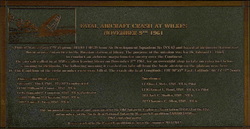
November 9th, 2011 marked 50 years since an overnight refuelling stop at Wilkes for a US Navy Neptune aircraft on its way back to McMurdo from the Russian station at Mirny, turned to tragedy. It crashed on take-off. The five men who had been seated around the supplementary long range fuel tank in the belly of the plane were incinerated; but remarkably, the four cockpit crew walked from the burning wreck and survived.
Bill Burch was present that year at Wilkes, and has been the main driver for a suitable memorial to the men who died. The Australian Antarctic Division organised for a stone cairn to be built by the Casey 2011 expeditioners on the hilltop overlooking Wilkes, beside the graves of Hartley Robinson and Reg Sullivan, Australians who had died in accidents in 1959 and 1968 respectively.
The ABC has shown a story of the dedication of the bronze plaque a few weeks back in memory of the Neptune crash at Wilkes in 1961. You can view the story on http://www.abc.net.au/news/2012-05-11/tragic-anniversary/4007052 .
The Antarctic Division has also posted information on the unveiling of the plaque.
posted 13/5/2012
Bill Burch was present that year at Wilkes, and has been the main driver for a suitable memorial to the men who died. The Australian Antarctic Division organised for a stone cairn to be built by the Casey 2011 expeditioners on the hilltop overlooking Wilkes, beside the graves of Hartley Robinson and Reg Sullivan, Australians who had died in accidents in 1959 and 1968 respectively.
The ABC has shown a story of the dedication of the bronze plaque a few weeks back in memory of the Neptune crash at Wilkes in 1961. You can view the story on http://www.abc.net.au/news/2012-05-11/tragic-anniversary/4007052 .
The Antarctic Division has also posted information on the unveiling of the plaque.
posted 13/5/2012
'Down South' book available

For over 60 years, Australian tradespeople have been drawn to the Antarctic by the prospect of great adventure and mateship. The scientists couldn't have remained in Antarctica and undertaken their research without the support and contribution of these skilled workers.
Susan Gordon-Brown, the photographer, has spoken to 25 tradespeople and photographed them as they are now. This book is a combination of these portraits and their stories, as written by Gayl O’Connor.
The book is a 12x12inch hardback book with good quality heavy paper with the storyboard one side and a photo on the other. The forward was written by Fred Elliott. The book can be previewed here... The book has been printed on top quality paper and displays beautifully.
Copies of the book can be ordered from Brian Harvey @$65 with postage to anywhere in Australia an additional $15. If interested,please ring Brian Harvey on 03 9754 5916 (H) or 03 9555 7019 (W).
posted 14/05/2012
Susan Gordon-Brown, the photographer, has spoken to 25 tradespeople and photographed them as they are now. This book is a combination of these portraits and their stories, as written by Gayl O’Connor.
The book is a 12x12inch hardback book with good quality heavy paper with the storyboard one side and a photo on the other. The forward was written by Fred Elliott. The book can be previewed here... The book has been printed on top quality paper and displays beautifully.
Copies of the book can be ordered from Brian Harvey @$65 with postage to anywhere in Australia an additional $15. If interested,please ring Brian Harvey on 03 9754 5916 (H) or 03 9555 7019 (W).
posted 14/05/2012
Latest Southern Ocean research
From AAD Website 4/5/2012
New research by teams of Australian and US scientists has found there has been a massive reduction in the amount of Antarctic Bottom Water found off the coast of Antarctica.
Comparing detailed measurements taken during the Australian Antarctic program’s 2012 Southern Ocean marine science voyage to historical data dating back to 1970, scientists estimate there has been as much as a 60% reduction in the volume of Antarctic Bottom Water, the cold dense water that drives global ocean currents.
Read more...
posted 4/5/2012
From AAD Website 4/5/2012
New research by teams of Australian and US scientists has found there has been a massive reduction in the amount of Antarctic Bottom Water found off the coast of Antarctica.
Comparing detailed measurements taken during the Australian Antarctic program’s 2012 Southern Ocean marine science voyage to historical data dating back to 1970, scientists estimate there has been as much as a 60% reduction in the volume of Antarctic Bottom Water, the cold dense water that drives global ocean currents.
Read more...
posted 4/5/2012
Antarctic waters changing due to climate
SYDNEY — The densest waters of Antarctica have reduced dramatically over recent decades, in part due to man-made impacts on the climate, Australian scientists said Friday.
Research suggests that up to 60 percent of "Antarctic Bottom Water", the dense water formed around the edges of Antarctica that seeps into the deep sea and spreads out through the world's oceans, has disappeared since 1970.
"This is a response to changes that are happening to climate in the polar regions, both natural and human causes," lead researcher Steve Rintoul, from the Australian government's science body the Commonwealth Scientific and Industrial Research Organisation, told AFP.
"It's not driving changes in climate, it's responding to changes in climate. So it's a signal to us that things are changing around Antarctica."
Scientists are not sure what is causing the phenomenon but Rintoul said the leading hypothesis is that as more of the ice on Antarctica melts around the edges of that continent, it adds fresh water to the ocean. Read more...
SYDNEY — The densest waters of Antarctica have reduced dramatically over recent decades, in part due to man-made impacts on the climate, Australian scientists said Friday.
Research suggests that up to 60 percent of "Antarctic Bottom Water", the dense water formed around the edges of Antarctica that seeps into the deep sea and spreads out through the world's oceans, has disappeared since 1970.
"This is a response to changes that are happening to climate in the polar regions, both natural and human causes," lead researcher Steve Rintoul, from the Australian government's science body the Commonwealth Scientific and Industrial Research Organisation, told AFP.
"It's not driving changes in climate, it's responding to changes in climate. So it's a signal to us that things are changing around Antarctica."
Scientists are not sure what is causing the phenomenon but Rintoul said the leading hypothesis is that as more of the ice on Antarctica melts around the edges of that continent, it adds fresh water to the ocean. Read more...
Search for life in Antarctic lake

from BBC news website
Crucial training has begun for a project to search for life in a lake hidden beneath the Antarctic ice-sheet.
Scientists and engineers are rehearsing the most challenging stages of the drilling operation planned for Lake Ellsworth.The goal is to gather samples of water and sediment in a hunt for microbial organisms and clues about past climate.
Training is focused on the handling of a water sampling device and a corer to extract sediment from the lake floor. “This level of hygiene has never been attempted before in the exacting conditions of a polar region.” To avoid contamination, the drilling has to be undertaken in conditions cleaner than those required in an operating theatre. Read more....
Crucial training has begun for a project to search for life in a lake hidden beneath the Antarctic ice-sheet.
Scientists and engineers are rehearsing the most challenging stages of the drilling operation planned for Lake Ellsworth.The goal is to gather samples of water and sediment in a hunt for microbial organisms and clues about past climate.
Training is focused on the handling of a water sampling device and a corer to extract sediment from the lake floor. “This level of hygiene has never been attempted before in the exacting conditions of a polar region.” To avoid contamination, the drilling has to be undertaken in conditions cleaner than those required in an operating theatre. Read more....
Fire on Aurora Australis
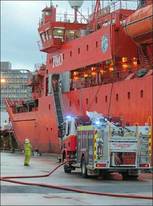
By Brian Ward, The Mercury 4th may 2012
FIRE crews rushed to Australia's Antarctic ship, the Aurora Australis, yesterday after a laundry fire.
The fire was caused by a tea towel spontaneously combusting inside a laundry room dryer on the ice-breaking vessel docked at the Hobart waterfront.
Read more here...posted 4/5/2012
FIRE crews rushed to Australia's Antarctic ship, the Aurora Australis, yesterday after a laundry fire.
The fire was caused by a tea towel spontaneously combusting inside a laundry room dryer on the ice-breaking vessel docked at the Hobart waterfront.
Read more here...posted 4/5/2012
DOWN SOUTH at Brisbane Powerhouse in May 2012
Susan Gordon Brown has forwarded an invitation for all ANARE expeditioners and friends to attend the opening of 'Down South' on Thursday 10th May 6pm at the Brisbane Powerhouse. (see invite above)
Susan is also keen to talk to any pre 1980 ANARE tradespeople who live in the Brisbane area who would be willing to be interviewed by media to add a local interest angle to the exhibition promotion. If you can help please contact Susan directly on email or phone 0407 366332.
Where: Brisbane Powerhouse
When: Wed 9 - Tues 29 May 2012
Cost: free
For over 60 years, Australian tradespeople have been drawn to the Antarctic by the prospect of great adventure and mateship. Plumbers, electricians, carpenters, diesel mechanics, cooks, radio operators and weather observers were the mainstay of the Antarctic home base. The scientists couldn't have remained in Antarctica and undertaken their research without the support and contribution of these skilled workers.
The great explorer, Sir Douglas Mawson, led the first Australian Antarctic Expedition (AAE) 100 years ago this year. One of the activities celebrating a centenary of Australia's involvement and Mawson's historic achievements is a photographic exhibition Down South,which tells the stories of the fabulous men and women who have ventured to the Antarctic from 1947 to the 1980’s.
Susan Gordon-Brown, the photographer, has spoken to 25 tradespeople and photographed them as they are now. They are now between the ages of 50 and 93 years old. The exhibition is a combination of these portraits and their stories, as written by Gayl O’Connor.
Born and bred in Australia, Susan Gordon-Brown has close to two decades of photography experience, working at a national and international level. Prior to settling in Melbourne in 2000, Susan lived and worked in London for 10 years, where she studied photography at the City of Westminster College. She has a broad range of expertise, with a portfolio covering corporate publications, national newspaper and specialist magazine assignments, public relations work, new media, live music and fashion events. In recent years, Susan has staged well received historical photo documentary exhibitions including “56 Faces”, a moving tribute to Australians who survived the 1956 Hungarian uprising, and “40 Days”, an exploration of cultural and religious practices of contemporary Australia.
Susan’s specialist area is portrait photography, where past subjects have included Stephen King, comedian Bill Cosby and blues legend BB King. Her portfolio is testament to the fact that her subjects immediately relax in her company, trusting her to produce the photograph that shows the true person.
Susan is a member of The MAP Group, a collection of acclaimed Australian photographers who document important Australian issues and topics. Susan’s photographs of drought-ravaged Australia were featured in the group’s recently released book, “Beyond Reasonable Drought”.
Susan Gordon Brown has forwarded an invitation for all ANARE expeditioners and friends to attend the opening of 'Down South' on Thursday 10th May 6pm at the Brisbane Powerhouse. (see invite above)
Susan is also keen to talk to any pre 1980 ANARE tradespeople who live in the Brisbane area who would be willing to be interviewed by media to add a local interest angle to the exhibition promotion. If you can help please contact Susan directly on email or phone 0407 366332.
Where: Brisbane Powerhouse
When: Wed 9 - Tues 29 May 2012
Cost: free
For over 60 years, Australian tradespeople have been drawn to the Antarctic by the prospect of great adventure and mateship. Plumbers, electricians, carpenters, diesel mechanics, cooks, radio operators and weather observers were the mainstay of the Antarctic home base. The scientists couldn't have remained in Antarctica and undertaken their research without the support and contribution of these skilled workers.
The great explorer, Sir Douglas Mawson, led the first Australian Antarctic Expedition (AAE) 100 years ago this year. One of the activities celebrating a centenary of Australia's involvement and Mawson's historic achievements is a photographic exhibition Down South,which tells the stories of the fabulous men and women who have ventured to the Antarctic from 1947 to the 1980’s.
Susan Gordon-Brown, the photographer, has spoken to 25 tradespeople and photographed them as they are now. They are now between the ages of 50 and 93 years old. The exhibition is a combination of these portraits and their stories, as written by Gayl O’Connor.
Born and bred in Australia, Susan Gordon-Brown has close to two decades of photography experience, working at a national and international level. Prior to settling in Melbourne in 2000, Susan lived and worked in London for 10 years, where she studied photography at the City of Westminster College. She has a broad range of expertise, with a portfolio covering corporate publications, national newspaper and specialist magazine assignments, public relations work, new media, live music and fashion events. In recent years, Susan has staged well received historical photo documentary exhibitions including “56 Faces”, a moving tribute to Australians who survived the 1956 Hungarian uprising, and “40 Days”, an exploration of cultural and religious practices of contemporary Australia.
Susan’s specialist area is portrait photography, where past subjects have included Stephen King, comedian Bill Cosby and blues legend BB King. Her portfolio is testament to the fact that her subjects immediately relax in her company, trusting her to produce the photograph that shows the true person.
Susan is a member of The MAP Group, a collection of acclaimed Australian photographers who document important Australian issues and topics. Susan’s photographs of drought-ravaged Australia were featured in the group’s recently released book, “Beyond Reasonable Drought”.
Brisbane times on 'Down South' exhibition

Enid Borshmann.
Famous and glorified, the explorers of Antarctica have names everyone knows such as Mawson, Amundsen, and Hillary. Touted too are the scientists of today who lead the Federal Government's Australian Antarctic Division through breakthroughs in the blistering cold.
But what about the people who made life in Antarctica possible for these brilliant minds and brave adventurers - where are the tributes to the tradespeople of the South Pole? In essence, there aren't any, according to Brisbane-born photographer Susan Gordon-Brown, who has sought to capture the stories of the blue-collared men and women behind Antarctica's “boffins” (their word for Antarctic scientists). Read more...
But what about the people who made life in Antarctica possible for these brilliant minds and brave adventurers - where are the tributes to the tradespeople of the South Pole? In essence, there aren't any, according to Brisbane-born photographer Susan Gordon-Brown, who has sought to capture the stories of the blue-collared men and women behind Antarctica's “boffins” (their word for Antarctic scientists). Read more...
Penguin census counted from space
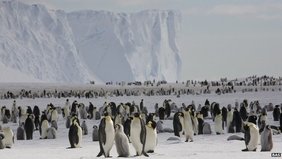
By Jonathon Amos, BBC news
Nearly twice as many emperor penguins inhabit Antarctica as was thought.
UK, US and Australian scientists used satellite technology to trace and count the iconic birds, finding them to number almost 600,000. Their census technique relies in the first instance on locating individual colonies, which is done by looking for big brown patches of guano (penguin poo) on the white ice. High resolution imagery is then used to work out the number of birds present. It is expected that the satellite mapping approach will provide the means to monitor the long-term health of the emperor population. Read more...
Nearly twice as many emperor penguins inhabit Antarctica as was thought.
UK, US and Australian scientists used satellite technology to trace and count the iconic birds, finding them to number almost 600,000. Their census technique relies in the first instance on locating individual colonies, which is done by looking for big brown patches of guano (penguin poo) on the white ice. High resolution imagery is then used to work out the number of birds present. It is expected that the satellite mapping approach will provide the means to monitor the long-term health of the emperor population. Read more...
Move under way to save distinguished ice breaker
Washington Examiner
The ice breaker that helped found McMurdo Station on Antarctica, was once the flagship of Rear Adm. Richard E. Byrd and performed a record-breaking 39 Arctic and Antarctic deployments may become scrap despite more than a decade of repairs and studies . Read more...
link supplied by Bill Storer with thanks
posted 19/4/2012
Washington Examiner
The ice breaker that helped found McMurdo Station on Antarctica, was once the flagship of Rear Adm. Richard E. Byrd and performed a record-breaking 39 Arctic and Antarctic deployments may become scrap despite more than a decade of repairs and studies . Read more...
link supplied by Bill Storer with thanks
posted 19/4/2012
Vale Peter Gormley C73, M77, RT every year from 1978-95
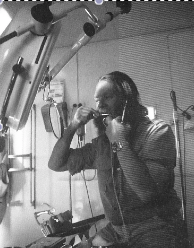
Peter Gormley drilling his own tooth abscess.
Des Lugg and Jeff Ayton have advised of the passing of Dr Peter Gormly, formerly Senior Medical Officer of the Australian Antarctic Division. Peter died after a brief illness at the Royal Hobart Hospital on 24/3/2012 just shy of his 75th birthday and is survived by his wife , Mrs Lorraine Gormly, and daughter, Kirsty Gormly and family, of Adelaide, and his son Andrew in London.
Peter was born and studied, in New Zealand, yet working as an orthopaedic surgeon in the remote Isles of Scotland he successfully applied for ANARE in 1972 after being interviewed by Sir Vivian Fuchs. He wintered at Casey Station in 1973, returning to Melbourne AAD Head Office in 1974 to complete human biology and medicine research projects. After a sojourn at the Canberra Hospital, Peter wintered at Mawson Station in 1977 where he conducted research into megadosage Vitamin C intake amongst expeditioners. His medical and surgical expertise was well utilised during the year in medicine and veterinarian practice including a laparotomy for bowel obstruction on Deefa, the Husky.
Peter was permanently appointed to AAD Head Office as a Medical Officer on 22 November 1978 and acted as Head of Polar Medicine during 1979, in the absence of Dr Des Lugg, who was undertaking sabbatical studies in Cambridge. In April 1981, Peter moved to Hobart and his Blackman’s Bay home following the AAD’s transfer from Melbourne, and was Senior Medical Officer until his retirement in 2007. Peter was well known for his skills and experience in first aid, field survival and celestial navigation. On the former, he was responsible for the famous guides and first aid manuals used by Antarctic expeditioners, mountaineers and trekkers around the world. His short course and guide to celestial navigation attended by many, simplified and opened their eyes to a skill oft forgotten.
Peter provided extraordinary continuity of service in the provision comprehensive Antarctic medical screening, Antarctic medical practitioner training and expeditioner training in Antarctic first aid with highlights of memorable and realistic simulations and presentations during the predeparture period, at Bernacchi training camps, or on the day of departure, that instilled a mantle of safety across Antarctic expeditioners and expeditions. Peter as an orthopaedic surgeon, was instrumental in cementing Antarctic expedition surgical capability into our modern day Australian Antarctic practice.
Dr Gormly’s experience as a P&O Orient Line Ships surgeon across the Atlantic, held him in good stead for his many voyages with the AAD where his skill and experience ensured the safety, well being and all round experience of those aboard.
In recognition of Dr Peter Gormly’s significant contribution to the Antarctic, he was awarded the Australian Antarctic Medal in 1991. He retired from the Australian Antarctic Division in 2007 after an association of 35 years with ANARE and the AAD.
Funeral arrangements: Turnbull Family Funerals , 71 Letitia St, North Hobart at 10:00am on Friday 30 March 2012. All welcome.
Information supplied by Des Lugg and Jeff Ayton
posted 25/3/2012
Peter was born and studied, in New Zealand, yet working as an orthopaedic surgeon in the remote Isles of Scotland he successfully applied for ANARE in 1972 after being interviewed by Sir Vivian Fuchs. He wintered at Casey Station in 1973, returning to Melbourne AAD Head Office in 1974 to complete human biology and medicine research projects. After a sojourn at the Canberra Hospital, Peter wintered at Mawson Station in 1977 where he conducted research into megadosage Vitamin C intake amongst expeditioners. His medical and surgical expertise was well utilised during the year in medicine and veterinarian practice including a laparotomy for bowel obstruction on Deefa, the Husky.
Peter was permanently appointed to AAD Head Office as a Medical Officer on 22 November 1978 and acted as Head of Polar Medicine during 1979, in the absence of Dr Des Lugg, who was undertaking sabbatical studies in Cambridge. In April 1981, Peter moved to Hobart and his Blackman’s Bay home following the AAD’s transfer from Melbourne, and was Senior Medical Officer until his retirement in 2007. Peter was well known for his skills and experience in first aid, field survival and celestial navigation. On the former, he was responsible for the famous guides and first aid manuals used by Antarctic expeditioners, mountaineers and trekkers around the world. His short course and guide to celestial navigation attended by many, simplified and opened their eyes to a skill oft forgotten.
Peter provided extraordinary continuity of service in the provision comprehensive Antarctic medical screening, Antarctic medical practitioner training and expeditioner training in Antarctic first aid with highlights of memorable and realistic simulations and presentations during the predeparture period, at Bernacchi training camps, or on the day of departure, that instilled a mantle of safety across Antarctic expeditioners and expeditions. Peter as an orthopaedic surgeon, was instrumental in cementing Antarctic expedition surgical capability into our modern day Australian Antarctic practice.
Dr Gormly’s experience as a P&O Orient Line Ships surgeon across the Atlantic, held him in good stead for his many voyages with the AAD where his skill and experience ensured the safety, well being and all round experience of those aboard.
In recognition of Dr Peter Gormly’s significant contribution to the Antarctic, he was awarded the Australian Antarctic Medal in 1991. He retired from the Australian Antarctic Division in 2007 after an association of 35 years with ANARE and the AAD.
Funeral arrangements: Turnbull Family Funerals , 71 Letitia St, North Hobart at 10:00am on Friday 30 March 2012. All welcome.
Information supplied by Des Lugg and Jeff Ayton
posted 25/3/2012
Vale Neil Adams
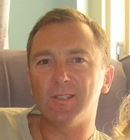
Neil Adams, the Manager of the Bureau's Antarctic Meteorological Section based in Tasmania and Antarctica Region passed away on Friday 23 March 2012 from meningitis after a short illness.
Neil's death is a huge loss to the Bureau and Antarctic community. He was well known and respected both nationally and internationally for his extensive work in polar meteorology over a 30 year period. He was a member of various committees including SCAR (Scientific Committee on Antarctic Research) Expert Group on Operational Meteorology, the International Commission on Polar Meteorology (ICPM), and the Steering committe for ths annual Antarctic Meteorological Observation, Modeling, and Forecasting Workshop (AMOMFW).
Most of all he was much liked by his colleagues and friends, and his death is a huge loss on a personal, as well as a professional level. Neil was warm, funny, friendly...and always an adventurer! He will be very much missed.
There are two events planned in memory of Neil.
Thursday 29 March 2012, 10.45-1pm Stanley Burbury Theatre, University of Tasmania: a celebration of Neil’s life at which all who have known him are invited to share their thoughts and reminiscences. At 1 pm, refreshments will be served.
Friday 30 March 2012, late morning: a memorial ceremony for Neil will be held on the slopes of Mt Wellington. Details to follow.
posted 25/3/2012.
Neil's death is a huge loss to the Bureau and Antarctic community. He was well known and respected both nationally and internationally for his extensive work in polar meteorology over a 30 year period. He was a member of various committees including SCAR (Scientific Committee on Antarctic Research) Expert Group on Operational Meteorology, the International Commission on Polar Meteorology (ICPM), and the Steering committe for ths annual Antarctic Meteorological Observation, Modeling, and Forecasting Workshop (AMOMFW).
Most of all he was much liked by his colleagues and friends, and his death is a huge loss on a personal, as well as a professional level. Neil was warm, funny, friendly...and always an adventurer! He will be very much missed.
There are two events planned in memory of Neil.
Thursday 29 March 2012, 10.45-1pm Stanley Burbury Theatre, University of Tasmania: a celebration of Neil’s life at which all who have known him are invited to share their thoughts and reminiscences. At 1 pm, refreshments will be served.
Friday 30 March 2012, late morning: a memorial ceremony for Neil will be held on the slopes of Mt Wellington. Details to follow.
posted 25/3/2012.
Melbourne Midwinter Dinner Information
Bookings are NOW open for Melbourne Midwinter dinner.
This year we are limited to 150 at the Bayview Eden, so please get your booking in EARLY.
Dinner bookings (drinks inclusive) are $90 before 10th June and $95 after 10th June.
See http://www.anareclub.org.au/local/melbourne/melbourne.htm for Information.
This is a members only event, so please ensure your membership is financial. Subs may be paid with bookings.
A booking form can be found at http://www.anareclub.org.au/local/melbourne/melbbooking.htm
If you are registered for online membership, then online bookings can be made.
Please check http://www.anareclub.org.au/local/melbourne/melbournemidwinterattendees.html to confirm your booking has been processed and for a list of those attending.
Info supplied by Denise Allen, national social secretary
posted 23/3/2012
4th Antarctica Art and Culture International Conference & Festival
When: 5-9 September 2012.
Where: Universidad Nacional de Tres Febrero, Buenos Aires
Call for Art exhibits and Papers
Following the fourth artistic research expedition to Antarctica, initiated by The Art and Cultural Program of the National Antarctic Direction (DNA), this event is convened to present results from the expedition and connect these to other art and academic research in the fields of Antarctic arts and culture.
Art exhibits and papers that relate to artistic research in Antarcica are welcome. However, the event aims to extend connections between disciplines. Connections with scientific disciplines, are encouraged, as are new approaches to familiar challenges, such as the marine resource and climate change debates. While the primary focus of the conference is Antarctic, papers which combine Antarctic and Arctic material are welcome. For more information click here...
The Art and Cultural Program of the National Antarctic Direction (DNA) promotes research into the aesthetic values of the Antarctic environment. The program enables artists to experience Antarctica and to witness scientific research undertaken there. Artists are selected annually to join the Antarctic summer science research program (Between November and March). Results of artists' research are presented in national and international events worldwide.
Thanks to Lisa Roberts for providing information.
posted 22/3/2012
Bookings are NOW open for Melbourne Midwinter dinner.
This year we are limited to 150 at the Bayview Eden, so please get your booking in EARLY.
Dinner bookings (drinks inclusive) are $90 before 10th June and $95 after 10th June.
See http://www.anareclub.org.au/local/melbourne/melbourne.htm for Information.
This is a members only event, so please ensure your membership is financial. Subs may be paid with bookings.
A booking form can be found at http://www.anareclub.org.au/local/melbourne/melbbooking.htm
If you are registered for online membership, then online bookings can be made.
Please check http://www.anareclub.org.au/local/melbourne/melbournemidwinterattendees.html to confirm your booking has been processed and for a list of those attending.
Info supplied by Denise Allen, national social secretary
posted 23/3/2012
4th Antarctica Art and Culture International Conference & Festival
When: 5-9 September 2012.
Where: Universidad Nacional de Tres Febrero, Buenos Aires
Call for Art exhibits and Papers
Following the fourth artistic research expedition to Antarctica, initiated by The Art and Cultural Program of the National Antarctic Direction (DNA), this event is convened to present results from the expedition and connect these to other art and academic research in the fields of Antarctic arts and culture.
Art exhibits and papers that relate to artistic research in Antarcica are welcome. However, the event aims to extend connections between disciplines. Connections with scientific disciplines, are encouraged, as are new approaches to familiar challenges, such as the marine resource and climate change debates. While the primary focus of the conference is Antarctic, papers which combine Antarctic and Arctic material are welcome. For more information click here...
The Art and Cultural Program of the National Antarctic Direction (DNA) promotes research into the aesthetic values of the Antarctic environment. The program enables artists to experience Antarctica and to witness scientific research undertaken there. Artists are selected annually to join the Antarctic summer science research program (Between November and March). Results of artists' research are presented in national and international events worldwide.
Thanks to Lisa Roberts for providing information.
posted 22/3/2012
AAD appoints new chief scientist
The AAD has announced that Dr Nick Gales has been appointed as the new Chief Scientist. Read more...
The AAD has announced that Dr Nick Gales has been appointed as the new Chief Scientist. Read more...
Aliens in Antarctica
from the SCAR website (Scientific Committee of Antarctic Research)
20 March 2012
Invasive alien species are among the primary causes of biodiversity change globally, with the risks thereof broadly understood for most regions of the world. They are similarly thought to be among the most significant conservation threats to Antarctica, especially as climate change proceeds in the region. However, until now no comprehensive, continent-wide evaluation of the risks to Antarctica posed by such species has been undertaken.
Steven Chown of Stellenbosch University in Matieland, South Africa, and colleagues vacuumed the clothes and bags of some 33,000 tourists and 7100 scientists who visited Antarctica between 2007 and 2008. They found an average of 10 plant seeds on each visitor. Many had visited other cold places, so they were carrying species like the Arctic poppy that were likely to survive in Antarctica's chilly climate. Scientists, especially field scientists, were five times seedier than tourists.
Most seeds were grasses or dandelions, which make good invaders, especially as global warming makes Antarctica more hospitable. Poa annua, an annual bluegrass, is already spreading around four research stations.
Antarctica has a lot of unique biodiversity, Chown says. "Colonising species could transform these landscapes to the detriment of indigenous species," he says, besides making them drably similar to landscapes elsewhere. While colonisation happens naturally, he says, humans raise the rate and carry species that wouldn't arrive on their own.
Why does this matter? "People would notice if we added a few random spots of bright pink paint to a Rubens," observes Chown. "Yet many blithely do the equivalent to natural systems without a hint of regret – who cares if we have Poa annua and rats everywhere?"
Read the full paper in the Proceedings of the National Academy of Sciences, DOI: 10.1073/pnas.1119787109
from the SCAR website (Scientific Committee of Antarctic Research)
20 March 2012
Invasive alien species are among the primary causes of biodiversity change globally, with the risks thereof broadly understood for most regions of the world. They are similarly thought to be among the most significant conservation threats to Antarctica, especially as climate change proceeds in the region. However, until now no comprehensive, continent-wide evaluation of the risks to Antarctica posed by such species has been undertaken.
Steven Chown of Stellenbosch University in Matieland, South Africa, and colleagues vacuumed the clothes and bags of some 33,000 tourists and 7100 scientists who visited Antarctica between 2007 and 2008. They found an average of 10 plant seeds on each visitor. Many had visited other cold places, so they were carrying species like the Arctic poppy that were likely to survive in Antarctica's chilly climate. Scientists, especially field scientists, were five times seedier than tourists.
Most seeds were grasses or dandelions, which make good invaders, especially as global warming makes Antarctica more hospitable. Poa annua, an annual bluegrass, is already spreading around four research stations.
Antarctica has a lot of unique biodiversity, Chown says. "Colonising species could transform these landscapes to the detriment of indigenous species," he says, besides making them drably similar to landscapes elsewhere. While colonisation happens naturally, he says, humans raise the rate and carry species that wouldn't arrive on their own.
Why does this matter? "People would notice if we added a few random spots of bright pink paint to a Rubens," observes Chown. "Yet many blithely do the equivalent to natural systems without a hint of regret – who cares if we have Poa annua and rats everywhere?"
Read the full paper in the Proceedings of the National Academy of Sciences, DOI: 10.1073/pnas.1119787109


